Text
Game Review: Pro Golf 2
Handheld Game, Bandai, 1988
Raw Dogging with LCD Golf
What if you were forced to spend a long flight with no entertainment, save for your own thoughts, your own imagination? Nothing to satiate your need for constant passive mental simulation? No parade of thirty second dance videos? No way to doom scroll through page after page of manufactured outrage? How would you cope? How would you feel, trapped within your narrow internal world, you pathetic little meat monkey?
What’s that? Commentaries on ‘Raw dogging’ were run into the ground in ‘24? …let’s put a little spin on it then, freshen it up for today's audience. What if you were forced to spend that time with only an 80’s LCD golf game to keep you company. How would that suit?

The pleasures of golf can be fully enjoyed.
I board the flight, and find my row. The plane is packed. I slip into the cramped economy seat, my mind buzzing with anticipation and trepidation. Half listening to the safety announcements, I try to calm my overheating brain. I know it's waiting for me in the bag tucked under my seat, sheathed in a slim fake leather folio case. I await the exhilarating burst of takeoff.
My choice of travel entertainment isn’t totally novel. I have some past history with these games.
Perhaps another less familiar with the form would provide a much better subject for this experiment?
Imagine if you, reader, were propositioned in an airport lounge by a complete stranger clutching a copy of LCD Pro Golf 2 asking if you want to be his ‘control group’, a wild, dangerous gleam in his eyes?
The flight is safely in the air, and it’s time to play. These golf games work because of the sheer lack of dynamism in the sport they are simulating. They can render a set of graphical elements in fixed positions and nothing more, so any motion portrayed is going to be constrained and jerky.
Like most games of this type, there’s a cycle of simple inputs the player makes when playing a round of 18 holes on this handheld. You’re presented with a view looking down the fairway towards the flag, with a clear indication of the number of yards to the hole, and an arrow showing wind direction (if any). You select which club you wish to use, each suitable for making shots at a different distance, from 1 wood to sand wedge. The shot range of each club is handily written into the instruction manual, tucked into a pocket of the folio.
But you shan‘t look there. You must be pure. You will memorise every one, reciting them to yourself in the mirror each morning, a koan to your new LCD god.
Once the club selection is made, you make the shot using a single button on the device. In this game (as in most of its peers) you do this by holding the button down, releasing at the end of the back-swing and pressing again when you’re about to strike the ball. The position of the golfer’s arm is used to gauge how strong that swing is - the further back you let it go, the further the ball will travel. There’s no aiming in this game, as such. Instead you must counteract the effects of wind by sending the ball to the left (hook) or right (fade) by pressing to hit the ball slightly early or late.
The plane banks sharply, briefly taking my attention away from my game. I realise my body aches from its confinement to this tiny seat. No. This is an illusion. I have no need for their refreshments today. No need for their cartoned orange juice and stale nuts. These are base, earthly temptations. I now have a higher purpose. I must save par on the 11th.
When you get within range of the hole, you switch to a putting view, and a small section of the screen indicates if there’s any slope to the green. You make adjustments for the camber by hitting slightly early or late, in just the same way as you adjust for wind. If successful, it's on to the next hole.

The next hole.
This is arguably the best LCD golf game of the handful I have played. It keeps things simple enough to pick up and play, but makes the most effort at providing the visuals for a varied course. There are mountains and forests, rivers and some holes where you are playing next to the sea. There’s a good variety of bunker positions. All of this is possible because the game uses 2 separate layers of LCD, a fairly rare advancement on these devices. The game has a handy 2 player mode, with each player taking a turn for their shot.
You want to join me for a game, don’t you? I can see your furtive glances over the top of the in-flight magazine. You’re itching to run your dirty fingers over my leatherette slipcase. No. I won’t share this game with you. You are incomplete. You are corrupt. You are unworthy.
As you continue to play, your understanding of how to make shots improves, and that’s because, for the most part, actions have relatable outcomes in this game. The only difficulty comes during putting, where due to the limitations of the format you don’t appear to be any closer to the hole, despite distance counter indicating that you are. The sound effects are worthless bleeps, but you can turn them off.
As I play on I enter an almost trance like state, the world falling away from me, There is no ‘I’, only golf. Beyond golf, the pitiless void.
0 notes
Text
Game Review: Super Mario Bros
Handheld Game, Nintendo, 1986 (my widescreen version 1988)

Time for another Game and Watch game. This one is a single screen effort, and one of the later releases from the line. In this ambitious LCD recreation of the hit NES scrolling platformer, you control Mario as he bloops though 8 different worlds on his way to rescue Princess Peach from the clutches of the Koopas.
The words you must traverse are:
Canyon
A scrolling level, where you automatically run along a series of flat platforms, and try to avoid falling down pits.
Gym
Another scroller, though this time you must jump through sets of obstacles which are now positioned in your way. Take care not to get trapped and crushed by the moving screen!
Burning Room
A single screen room where you have to avoid moving barriers to get to the princess.
Channel
An ‘underwater’ level where you make your way through the narrow channels, but float along instead of falling downwards.
Hop
Jump though the scrolling sky world. The platforms here are on multiple levels, with a more complicated arrangement.
Beam
Another single screen room where you must jump up a series of moving platforms to get over a high wall.
Maze
Pick your path carefully in this scrolling level, being careful not to get trapped.
Burning Road
The final challenge - avoid a series of moving barriers that will kill you on contact.
Once you get through the first set of 8 levels, you’ll see a short victory scene with princess peach and Bowser, king of the Koopas. You’ll then get to repeat the challenge, but this time faster, and with a couple of additional threats to make things harder.
Bullet bills (small bullet like enemies) appear from time to time at the right of the screen and shoot quickly to the left.
Lakitus (turtles riding on clouds) appear overhead and throw hammers downwards.
You start with 3 lives, though these can be recovered up to a maximum of 4 if you find a mushroom or earn sufficient points. The 8 worlds will loop up to 9 times... not that I have the patience to test this for myself!
It’s also possible to find a starman pickup, which will make Mario invulnerable to bullet bills or lakitus for a while.
History
I saw the earlier (and much rarer) crystal screen version of this game in Harrods on a trip to London. It was expensive, so there was no chance I’d have been able to afford one at the time, however much I lusted after it. I finally picked up a mini-keyring re-release in the 2000’s and the 1988 widescreen version off ebay a few years later.
Liked
This is as close to replicating a real multi-stage platform game in LCD format as is possible (at least with fixed-position character graphics), and is a really impressive effort considering those limitations. The variety involved in the gameplay makes this quite re-playable, and I certainly had more patience for it than I do for most of these LCD games nowadays. I felt a definite compulsion to get to the second set of 8 worlds to re-try them with the enemies present, and they certainly added an extra dimension to the gameplay.
All Nintendo’s game and watches are things of beauty, and I can see why collectors have driven prices sky-high. They feel solid in the hand, and look great as display pieces too.
Disliked
They didn’t go with a d-pad for this one, just a set of 4 rubbery buttons, and the controls really suffer for it. It’s not unplayable by any means, but I ended up playing the mini-keyring version more frequently due to its addition of the d-pad. Everything here is drawn with simple lines, which lends the game its flexibility, but robs it of some of the character of other games in the G&W line.
🙉
The game makes a beep every time Mario moves. Mario moves a lot in this game, so this soon becomes as welcome as having explosive diarrhoea in a space suit.
0 notes
Text
Game Review: Gauntlet
Handheld Game, Tiger, 1988

The 3D Gauntlet you've all been waiting for.
Tiger handhelds were not a significant feature of my childhood. Despite this fact, many people seem to have a love / hate relationship with them. There’s a preponderance of ‘angry gamer’ reaction videos on one hand, a recent physical re-release of a selection of units on the other. They're certainly a part of the modern retro nostalgia factory, and remembered as a gateway to video gaming for a certain generation.
One of the particularly noteworthy things about Tiger and their range of LCD games was their willingness to license the hell out of almost anything (and I mean ANYTHING) that might help shift some units. Sonic the Hedgehog, Afterburner, Outrun, Golden Axe, Street Fighter 2. Double Dragon…. M.C. Hammer?
My outsiders opinion on many of these handhelds is that they seem pretty poor even within the arena of LCD games. I can’t imagine how an attempt at a 1-on-1 or scrolling fighting game could be expected to work on such primitive electronics, and attaching the name of some hot new arcade license to these is just inviting disappointment from anyone familiar with the original game.
Despite this poor reputation, I do own a single Tiger LCD game - a licensed version of Gauntlet, the super popular 1985 Atari arcade game.
The first thing I need to state is that, obviously, this isn’t anything like playing Gauntlet in the arcade. In Tiger’s version of the game you can choose between 2 of the 4 arcade characters, the barbarian or the valkyrie. There’s a cosmetic difference to the choice, with some small LCD elements changed between each character (actually pretty clever!) and a slightly less aggressive bleeping noise when moving and firing as the valkyrie. Less superficially the barbarian starts with more health, but his attack is slower.
Upon pressing the start button you head off into a maze, which unlike the arcade is shown from a fixed perspective behind and slightly above your chosen character. Fairly simple lines are shown to represent the maze walls, and you can move in any of the 4 compass directions, as long as it doesn’t take you through a wall. The maze is populated with two different types of monster, a lizard man and some sort of hooded troll thing. These enemies move around the maze, and you can hit them once they’re next to you using the fire button. Too slow off the mark and they’ll score a hit on you, taking off a larger chunk of your health score, which is displayed as a number in the top right corner of the screen.
Just like real Gauntlet, your health continuously ticks down, and you use a little bit up every time you swing your weapon, which is a gameplay element I flat out dislike.
To aid you in your quest there items scattered throughout the maze:
Keys allow you to walk though one of the walls.
Potions (which the makers have labelled ‘bombs’ here because they didn’t trouble themselves with actually playing Gauntlet) kill all the monsters visible on the screen.
Health restoring flasks which ..restore health.. and look like potions with keys inside them because that's the best they could do with the fixed elements of the LCD screen.
The adventure is split into a series of distinct levels, and you appear to progress between them by walking a certain distance through the maze in any direction, rather than navigating to a specific point.
There are 4 areas you progress though, with a few levels set in each:
The Castle
The basic maze with no twists. You’ll only encounter lizard men here.
Dark Forest
The elements of the maze itself are unchanged from the castle, but now you face both lizard men and hooded trolls.
The Lost Caverns
The maze walls start moving about, making everything confusing and chaotic.
The Unseen
The maze walls are now invisible, making things an exercise in pure frustration as you helplessly try to find a path.
The last level in every location contains only health flasks, and you can dash about trying to refill as much as possible before moving to the next. Once you’ve completed the last level of The Unseen you simply loop back to The Castle.

History
Somebody told me one of the other kids at school had a Gauntlet handheld game. Since I’d never seen such a thing in the shops I assumed it was bullshit. When I found out as an adult that there actually was a Gauntlet LCD game I was intrigued enough to try and get one. There are various other handhelds that have a maze theme, and Tiger themselves have an earlier game ‘Mouse Maze’ that uses the same basic perspective. They also produced a Robin Hood game, released in the same year as Gauntlet, but that appears to be exactly the same game with altered graphical elements.
Liked
I’ve seen various modern opinions that this game is laughable rubbish, but to my eyes it’s a really impressive effort ...if you’re being objective about the limitations of the format. This game has very clever use of screen elements in order to create a 3D maze populated with different creatures. It has multiple different locations. You can play as multiple characters, and the choice affects the graphics, gameplay and sound. I’m pretty sure I’d have loved this if I’d played it in the 80’s.
Disliked
The physical feel of the controls, at least in my copy of this game, is really cheap and horrible to use. That may be partly down to its age - I don’t have another Tiger handheld to compare it to. Even though I just admitted to finding this quite an impressive effort, it was released only a year before the Gameboy was first introduced in Japan, and you’d be crazy to play Tiger Gauntlet if you had the choice of playing Super Mario Land.
🙉
Annoying sound. As ever.
8 notes
·
View notes
Text
Game Review: Donkey Kong
Handheld Game, Nintendo, 1982

I considered not covering this one. The game and watch line are almost certainly the most iconic of all handheld games of the 80’s, so you’ll find plenty written about them elsewhere... but this is a part of my collection, so it feels somehow wrong to leave it out.
In Donkey Kong, you must climb a building under construction to reach a massive gorilla (the titular Kong) who has kidnapped your girl and taken her to the very top. The action takes place over 2 separate screens. On the first, you must jump over the barrels that Kong sends your way, and make your way up a couple of ladders to reach the top screen. You can only jump where there is space above your head, and this is made more perilous in some places because of a girder that periodically moves above you. Get hit by a barrel or jump when the girder is there and you’ll lose a life.
If you make it to the top, you have to flip a switch, which causes a rope to swing that can then be grabbed. If you manage to time that right without getting flattened by one of Kong's barrels then you see a short animation where one of four cables holding up the top platform is removed. You then start again at the bottom of the building. Repeat three more times and Kong comes crashing down and you’re rewarded with some hearts from the girl.
Rinse and repeat with everything getting faster. You have 3 lives per game.

History
One of my classmates at school brought this in, and I loved it so much I got it for my next birthday. The one I have now is my original, a little scuffed up and abused, but still going strong. Our earliest version of the Antiques for Geeks site even had a browser based copy of this very game, which helped me land my first software job. For that alone I’ll be eternally grateful…
Liked
Everything about Nintendo Game and Watches screams (yes, screams!) quality, and they remain highly collectable. Comparing this to the creaky cheap plastic shells of the Tiger LCD games of the 90’s is like night and day. The controls are more comfortable and responsive than most game consoles of the era, so it’s no wonder the d-pad introduced here eventually became the accepted standard for controlling 2D games. The game itself is really pretty simple and repetitive, but fairly addictive despite that. Character artwork is iconic.
Disliked
Though a step above the simplicity of the very earliest handhelds in the Game and Watch line, this is still a very basic game, and you’ll see everything there is to see in a few minutes.
🙉
Annoying sound ...though at least pretty quiet this time!
1 note
·
View note
Text
Game Review: Pocket Scramble
Handheld Game, Grandstand (Licensed version of Epoch Scramble), 1983

In Pocket Scramble, you must pilot your ship over the surface of a planet on a deadly mission to destroy the enemy base. There are 5 distinct levels to the game, all presented in beautiful black and white LCD jerk-o-vision.
Level 1
Fly over a city, blowing up enemy ships as they launch from the surface to intercept you. The city is crudely represented by stacks of blocks moving from the right of the screen to the left. Take time to appreciate how much the enemy ships look like the alien tripods from War of the Worlds. You can blast them with a missile which flies out of the front of your ship, or a bomb that drops from its bottom, both activated by the single fire button. The city buildings cannot be destroyed, and your ship does not enjoy making contact with them.
Level 2
There are no more buildings so I guess you have now blasted off into space? A series of enemy ships approach from the right, moving up and down as they go and making it harder to hit them. Not much else to say here.
Level 3
Back over the city, and this is where shit gets real, because this time meteorites streak in from the right of the screen too. Which makes things pretty tricky because:
There there are copious meteorites.
The meteorites look uncannily like your bullets, since they’re made from exactly the same screen elements that your bullets are.
Level 4
You now enter the caves, a set of twisty passages where you must manoeuvre your ship to avoid walls, while blasting any enemy ships in your way. It’s best to hang back on the left side of the screen here (your ship can move in 4 directions) because sometimes you’ll be presented with 2 paths, one of which is always a dead end.
Level 5
Face off against the enemy base! The base fills the right side of the screen, and is protected by an energy shield and more ships. There’s a moving gap in the shield, and if you manage to get a missile through it the base explodes in a shower of blocks, and you get to start the whole thing over again… but faster. Blowing the base up took me a few attempts as it's actually fairly tricky.
This handheld Scramble makes no attempt to hide its closeness to the 1981 Konami arcade game of the same name, though I can see nothing on the packaging to indicate this is officially licensed. From gameplay to artwork to music, LCD and tabletop games from the 80’s commonly boosted other companies IP, so we shouldn't be too surprised.
History
I swapped this for a short time with a school friend for one of my other games. I’ve always considered it one of the better LCD games, so wanted to pick up my own copy when I started collecting these things. There seems to have been quite a few Scramble inspired tabletops around at the time too. There were VFD* tabletop units made by Epoch (again, licensed by Grandstand in the UK) and Tomy. I also have a pretty cool officially licensed Super Cobra by Entex, which plays in a very similar way.
* VFD : Vacuum Fluorescent Display. Those old tabletop games that had glowing neon screens.
Liked
This is another ambitious effort for an LCD game, with 5 very distinct levels, and clever use of graphical elements to make that possible. There’s even an end sequence of sorts once you destroy the enemy base. It’s fairly playable for an LCD game, and I did want to see if I could make my way though all the levels at least once.
Disliked
Button placement is quite poor, though you can get used to it after a while. They’re just too far apart, which seems to be a common theme for these Epoch handheld games.
I say this in every one of these handheld reviews, but the sound is poor. I'm getting tired of writing it every time, so from now on if you see the following symbol...
🙉
...you can safely assume it's something others would find irritating if you subjected them to it for too long.
I also found the final level where you have to destroy the base pretty frustrating - the jerkiness of the LCD elements switching on and off made it hard to work out any pattern to getting shots through the shield, resulting in it all feeling pretty random.
0 notes
Text
Game Review : Astro Warriors
Handheld Game, Grandstand (Licensed version of Epoch Space Dragon), 1984

In the generically named ‘Astro Warriors’, you pilot a spaceship through 3 repeating levels of action. Before the first stage begins, you’ll see a brief introduction scene where your ship takes off and flies through a ...launch tube... You'll need to make fairly heavy use of your imagination here, as what you really see is some vertical black bars appearing in 3 different positions in a crude approximation of movement. If you can’t fill in the blanks you’re not going to get very far with 1980’s handheld games.
Once launched, you face off against a wave of alien ships. Like most LCD games, the graphical elements appear in front of a drawn background. This one is of a planet’s surface; it and all the other game elements are depicted in a pseudo 3D perspective so it appears a little like you’re flying into the screen. Your ship can move and fire in one of 5 positions, so it’s just a case of trying to line up the enemy ships to hit them with your lasers (or whatever the hell the disc shaped things that come out of your ship are supposed to be). The bad guys can crash into you, just like in Galaxian, though the whole process of shooting them feels much more random than in that game.
If you survive the first wave, level 2 sees you flying down a tunnel, facing off against one ship after another. You can also crash into the walls. At any time during this level it’s only safe to move either to the left or the right, depending on which side the wall is closer. You’ll need to move regularly in order to avoid the aliens and their shots, but judging which side is the safe one can be a frustrating experience, given how crude the tunnel effect is. I found hammering the fire button to try and catch these bastards as soon as they appear on the screen was the most effective tactic.
The final stage is a face off against a boss dragon. This guy jerks around the screen, is made up of multiple sections, and loses one of those sections when you nail it with a shot. I’d have said this was an obvious tip of the hat to Space Harrier, if it wasn’t for the fact that it was released a year before Sega’s game. So... the hat remains perpendicular. Unless Sega were doing the tipping themselves? Very unlikely given their well documented hatred of angled hats.
Once all the sanctions of the dragon have gone, you get to start the run of levels again, but faster.
My biggest single issue with this one is the layout of the controls. You’re clearly meant to hold it in 2 hands, but the buttons on the right that are used to move the ship are very far apart. I ended up holding it solely on one side so I could reach the ship controls with both thumbs. This just seems like poor design. Perhaps they were trying to stay away from anything that looked too much like a d-pad to avoid the legal attention of Nintendo?
Though my copy was sold under license by Grandstand in the U.K. this game is actually a re-branded ‘Space Dragon’ from the Japanese toy company Epoch, who produced many fine tabletop games at the time. ‘Space Dragon’ sums this game up much better than ‘Astro Warriors’.
History
Played once while visiting one of my Dad’s teacher friends, who had a sailing boat and liked to watch the British Saturday night sailing soap opera ‘Howard’s Way’. Many years later my nostalgia prompted me to pick up my own copy of ‘Astro Warriors’, but (to date) I own no ‘Howards Way’ box set.
Liked
More ambitious than the average LCD handheld. Smart use of segmented LCD display to produce different scenes and enemies, particularly for the dragon boss. Having an animated intro scene is pretty fancy stuff for one of these games.
Disliked
Gameplay feels more like luck than skill at times. The second stage with the tunnel walls was no fun at all. The controls are poorly laid out. Nasty sounds and bleepy tunes, as usual, but no way to turn them down. Or off.
0 notes
Text
Game Review : Tomytronic 3D Sky Attack
Handheld Game, Tomy, 1983

Introduction
I've always enjoyed collecting retro handhelds. From the beginning, they were an ever present feature of car boot sales and second hand shops, unwanted and unloved. They're primitive, often barely playable, and superseded by many generations of vastly superior portable entertainment. And yet, they're often appealingly tactile, generally reliable and (usually!) small and easy to store. Though many can now be emulated in MAME, playing them that way really won't give you the full experience of holding one in your hands.
This is the first of a short series of articles on my collection. It is the perfect example of something that can't really be experienced without going back to the hardware itself.
The Game
The Tomytronic 3D range was a series of LCD games where the player looked into a pair of futuristic contoured binoculars to see the action. There were 7 games in the series, but they all basically worked the same way; the player looked into the eye pieces, saw a 3D image on the screen and controlled the action with some buttons handily placed on the top of the case where you grip it.
Inside you could see a coloured LCD display of your game, lit through a translucent panel in the top of the device. There’s no backlight here, so no way to sneak a go after lights out.
The USP of this series, as the name suggests, is that the display is in stereoscopic 3D. The sense of depth is quite effective, helped by the simple nature of the game ‘graphics’. This was achieved with nothing more fancy than simply having 2 slightly different sections of the LCD panel, each with their perspective corrected for an eye.
One of the main issues I have with most of these old handhelds is the restricted and mechanical nature of the gameplay. Everything moves within set channels to a palpable beat, just like watching the figures changing on an LCD watch. The actual gameplay of 3D Sky Attack is no different. There are 3 lanes of enemy spaceships which will approach from the horizon. You control a defending tank at the bottom of the screen, and must manoeuvre between these 3 lanes, shooting the enemies down when they reach the middle distance to score points. If you miss any enemies, they’ll fire a shot into one of the channels once they reach your tank. These can be avoided, but as the levels progress the enemies get faster, more numerous and more aggressive, until keeping your ship away from their fire becomes almost impossible. At the end of each level there’s a sort of bonus stage where you have to shoot down fast moving ships one-at-at-time for extra points.
Sound effects are typical bleeps, bloops and simple single channel tunes, with a continuous buzzing noise that I assume is supposed to be your tank, but sounds more like a wasp trapped in a lunchbox. Thankfully, for the sanity of anyone nearby, you can easily switch all the sounds off.
I would describe the ‘graphics’ displayed on the multi-coloured LCD panel as inspired by the 80’s Disney computer world film TRON. Honestly... they’re really a pretty shameless ripoff, but the art style works well, with the outlines of the tank and enemy ships standing out clearly against a black background.

Primordial VR
These games seemed to be popular in the UK, with Sky Attack, and the futuristic car racing effort Thundering Turbo seeming to be the most ubiquitous. That means they’re readily available second hand, though like all things retro the prices have increased steadily over time to the point where I wouldn’t personally consider buying one as an impulse purchase now.
History
I had a version of this as a kid, bought on holiday in Argos on Sauchiehall Street, Glasgow, with money given by generous relatives.
Liked
The design of these things is appealing, and they’re sturdily built. The 3D effect actually works, and makes the game much more immersive than the average game of this type. The controls are well thought out, easily accessible and responsive.
Disliked
The sound is typically basic and annoying. Once you get past the fancy effects, the gameplay is actually pretty vanilla, with very limited elements.
0 notes
Text
Kolchak : The Night Stalker at 50 - They have been, They are, They will be...

This week, Carl runs into something out of this world
And so, just before Christmas 1991, with the end of the Mystery Train nights on BBC2, our brief introduction to the world of Kolchak was over, along with Richard O’Brien’s time as the overlord of the Tube station.
Kolchak signed off for the last time under O’Brien’s care with the series finale, The Sentry; any sneer and snark from our presenter possibly lost to the mists of time.
In some ways, it was all rather sad; here had been an opportunity to have a strand of cheap (for the BBC, at least) horror programming in the run-up to Christmas. The show would have easily taken care of Halloween each year. The timeslot - 23:15 - was nicely inconspicuous too, away from the prying eyes of children and time that some would argue should be given over to more mainstream programming. Plus, the pubs back then closed at 23:30, so no doubt there would have been viewers dribbling in, looking for something to watch until entering the sweet embrace of sleep, their wallets having escaped the loving grasp of the stout yeoman of the bar.
The format, was sound. The BBC had the material in its archives that it could quite happily have used for the serial - shows like The Omega Factor, Doomwatch even a thirst for ITC shows like UFO. There was even the grand-daddy of televised sci-fi horror, Quatermass, although incomplete.
But it was not to be. Instead, a few months later in June 1992, Kolchak returned on Sunday nights for another run. Once again on BBC2, right after Moviedrome (presented at the time by director Alex Cox). Memory plays tricks once more - for years the assumption was that Alex Cox presented the episodes too, but this was the memories of Moviedrome and Mystery Train merging into one.
A less regimented start time for the series on Sunday nights meant that it wasn’t always possible to watch live; so out of necessity, the episodes were taped. If you were lucky enough to remember or not had your VCR privileges revoked, that is. And that’s how Kolchak came to be stuck in our collective memory. Video tapes that contained a handful of episodes, recorded in the summer and autumn of 1992, watched over and over. Complete with BBC2 continuity intros. Never to be taped over, always to be kept to one side.
Chopper, Horror in the Heights, Legacy of Terror, Mr R.I.N.G., Primal Scream, The Ripper, The Trevi Collection, The Knightly Murders, Demon in Lace.
A repeat airing of the TV Movies in 1993 was added, and they too were committed to their tapes, never to be wiped. But more of that another time.
Then that really was it. Since then, neither the series or the films have darkened the hallways of the BBC again.
There were repeat airings in the UK on Sci-Fi when it wasn’t betrothed to cheap blockbuster knock-offs made by The Asylum, but for that you needed Sky or cable TV. For most people, it was a case that if it didn’t turn up on terrestrial TV, it didn’t happen.
Getting it on home media was also difficult. In a small town asking WH Smith to look it up to see if it was available on VHS resulted in a blank look, ditto the video rental shop.
Sure, it was available on VHS, but only in the states - and only two episodes per tape. You’d need NTSC playback on your video recorder (fortunately mine did) but how would you find it? There was no internet in 1992 for us to look for a supplier in the states and even when there was, finding one prepared to ship to the UK affordably was a different matter again.
But in 1995, things changed. Before social media came along and made everyone mad and shouting at each other, people who could get online started to be able to build websites with companies like Geocities, Tripod or Fortune City. And so people started to put up material about their favourite TV series. Although there would be no video to begin with, here for the first time, we were able to see personal episode guides, and in return share what we thought of the show. Plus, there was more general information about the series itself; behind the scenes stuff, much of it apocryphal but not intended to mislead or cause mischief. Genuine stuff, like confusing Robert Beltran and Erik Estrada and somehow thinking the former was in Legacy of Terror. Which would have been quite something given the age difference between the two actors.
Finally, as it started to become affordable to digitise video, episodes started to appear online and we were able to see the episodes that we’d missed ten or fifteen years before. And then the final piece of the jigsaw arrived - Kolchak on DVD. Here he was in all his glory, and available in Region 2 so that us Europeans could catch up with him properly. The transfer from video was respectable, rather than fantastic, but at last there he was, all 20 episodes available and easy to watch.
And now? None of these shenanigans - £1.89 an episode on iTunes, or possibly free on streaming, although it flits around platforms. No doubt a low quality version to borrow is on the Internet Archive too. All available to watch when you want, how you want.
But for all that convenience, there’s something we’ve lost; having to make an appointment with Richard O’Brien on a Friday night and the serendipity of not quite knowing which episode you were going to get…

The visitor attacks a befuddled cheetah in Chicago Zoo. With all that hay blown at it in the name of special effects, I hope it was on Equity rates.
Plot
Chicago (or Kolchak, at least) is gripped by the Cub’s return to the Baseball World Series. There’s a number of strange events in the background - radio reception across the city is awful, animals are dropping like flies in the city zoo and electronic components are disappearing left, right and centre.
The only thing linking these events seems to be a strange goo appearing where these events take place, and shadowy figures very keen to remove all trace that anything ever happened.
Guests
Darren McGavin and Simon Oakland were joined by :
James Gregory - Captain Quill
Mary Wickes - Dr. Bess Winestock
Maureen Arthur - Woman Speaker
Dick Van Patten - Alfred Brindle
Jack Grinnage - Ron Updyke
Carol Ann Susi - Monique Marmelstein
John Fielder - Gordon Spangler
Rudy Challenger - Stanley Wedemyer
Phil Leeds - Howard Gough
With
Len Lesser - Crowley
Fritz Feld - Waiter
Tony Rizzo - Leon Van Heusen
Dennis McCarthy - Guard
The Scoop
Pop : I had no strong memories of watching this episode before, and on re-watching I can see why. On the plus side, though it still contains a lot of the same familiar elements from the previous two episodes it at least has a different look and feel, with plenty of scenes short during the day.
There’s also some good interplay with the other members of the INS team, and Darren McGavin is always watchable as Kolchak.
The plot feels more like a typical X-Files episode than usual, and a scene where an invisible force blows out a wall even prompted my wife (who is a big X-Files fan) to wonder if it was caused by the elephant turned invisible by aliens from an extremely silly early episode of that show.
Despite all that, this one felt a little flat to me. The invisible alien was a good idea - anything else would have been almost impossible to pull off without looking ridiculous - but it never felt genuinely threatening.

Mysterious lumps of goo are found at the sites of odd goings-on and Carl is determined to science the heck out of it to get answers.
Tim : I fell asleep during this episode back in 1991 and woke to the end where all I remembered were dancing lights on what seemed to be a washing airer. Such was my befuddled state.
After that however; it gained notoriety. Pop, who managed to wedge his eyelids open for long enough to get to the end, didn't rate the episode at the time. Reading about it in later years, it really didn’t disabuse me of my feeling that I’d not missed out. When I finally did get to watch a copy online over a decade later, I wasn’t taken by it at all. The whole episode seemed pretty poor.
But on watching it back for this review, I finally got it. Maybe it’s just time and experience, but there seem to be strong parallels with The Quatermass Experiment. Envisage Kolchak as the titular Quatermass and you get the idea. A man trying to understand what is going on with something he can’t comprehend because the only frame of reference - the earthly - doesn’t align. Only by stripping back and casting its behaviour in human terms, and mundane ones at that, does he make any kind of sense of the alien’s real motive.
Part of the link for me to the style of the Quatermass serial is the alien eye-view of the attacks similar to those in the films, the scientist who lets Kolchak know more than she should. Gordo the Ghoul making sure Kolchak isn’t led astray by the superficial willingness of the authorities to cooperate while at the same time, masking shadowy Government agencies’ work to keep proceedings under wraps. A defeated, deflated Vincenzo warned off from his agency pursuing the story.
But the real clincher is the last 15 minutes with Kolchak and the alien in the observatory. Surprisingly, it works. Sure there are compromises - the lack of any physicality of the Alien during the sequence,other than the effects of its actions in the form of knobs that twiddle on their own, may seem something of a let down, but producing a convincing creature would have been nigh on impossible on the budget and risked taking the audience out of the moment.
You can already see the budget being stretched ultra-thin with the effects they did choose to use. The explosion in the daytime raid on Raydine Electronics is quite the scene and when we lay our eyes on the Alien’s craft, the moment certainly doesn’t underwhelm.
We also see in this episode the world of Kolchak evolving. More than the films, everyone, it seems, hates Carl. With the possible exception of Vincenzo and an unlikely kindred spirit in Monique Marmelstein. Kolchak’s sheer force of will is what’s carrying him through.
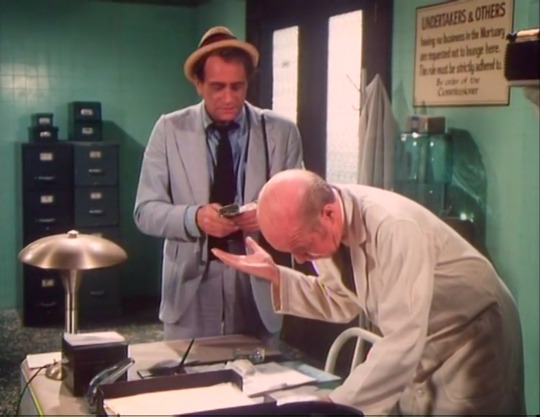
Gordo, as always upholding the highest of ethical standards.
Highlight
Pop : The scene where the alien visitor bursts through the wall at Raydine Electronics, sending out a shower of breeze blocks blowing and police officers over their squad cars. Given that this is a cheap old series and it’s shot in the blazing sunlight it looks surprisingly good!
Tim : Carl and Vincenzo discussing the evolving story while Vincenzo has a fine dining chef to serve his every need turns from the comic to the tragic with the intervention of mysterious ‘men in suits’. A small moment in the story, but one that sells the news men's desire for the story meeting the reality of censorship for the greater good. Simon Oakland really sells this moment, his words saying one thing, his physical performance another. It’s at moments like these in the series, you are reminded just how good our leads are.

Carl runs towards the denouement; shots like this add to the Quatermass feel of the story.
Lowlight
Pop : I was disappointed by the standoff with the alien at the observatory near the end. It goes on too long, and the sequence of events is confusing. We also see the same shot of dials being twiddled by invisible hands about five times too many. I felt that the tension generated by the confrontations with the weekly monster in the previous episodes was mostly absent here.
Tim : The alien “attacks”. They just don’t work for me, especially one where a poor cheetah has hay blown at it and then freeze-frames on it looking confused. Doesn’t feel like an alien attack; it feels like someone “messing about and finding out” when the cheetah’s fight or flight instinct kicks in and the cameraman ends up with an arm off.
Updyke vs. Kolchak
‘Uptight’ is back and has been appointed the acting sports editor. He’s still an insufferable weasel as he tries to avoid giving Carl his reward for saving Updyke’s skin. Kolchack runs rings around him in their scene, Easy win for Carl.
Updyke 0 - 2 Kolchak
Score on the doors
Pop : Started off well, and I appreciated the different tone set here, but it failed to stick the landing 4/10
Tim : A strong story, let down by having ideas bigger than its budget. Still good. 7/10
#afg#antiquesforgeeks#kolchak: the night stalker#carl kolchak#kolchak50#the night stalker#AfG Kolchak 50
1 note
·
View note
Text
Kolchak : The Night Stalker at 50 - The Zombie
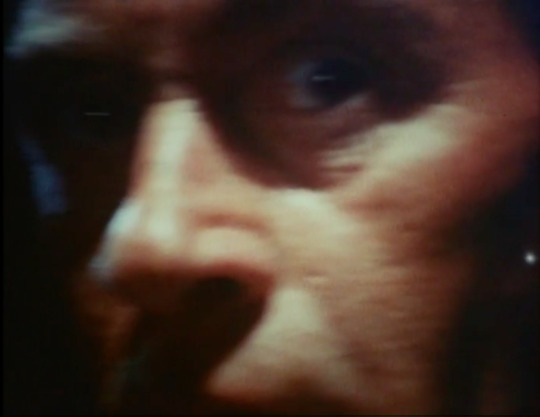
This week, Carl will mostly be dealing with a zombie.
Eight weeks is all the BBC’s introduction to Kolchak amounted to. Although all 20 episodes were available, a decision had been taken to show them out of US broadcast order in their late night Mystery Train strand. Maybe, you’d assume, the BBC went for episodes more in the overall theme when bundled with that evening’s short and film, but it doesn’t seem to be the case.
Maybe the series curator just liked these episodes best.
Maybe the Director General just threw darts at a board and those were the episode numbers they chose to air.
When the first Mystery Train appeared at a quarter past eleven on Friday October the 11th 1991, it kicked off eleven with the fifth episode of the Kolchak series, The Werewolf. Confusingly we’d have to wait until October the 25th for the series’ second episode, The Zombie, that US audiences had seen on the 20th of September 1974.
Presenter Richard O’Brien hammed up the episode introductions for the camera on a spookily deserted, low lit tube station where the titular train stood at the platform, shrouded in a generous cloak of smoke to aid the ambiance. Memory plays tricks, however. Watching a clip back today however, the station wasn’t quite deserted. It was full of statues of people doing what people do in stations every day of every week of every month of every year. Going about their business.
youtube
A welcoming character, wouldn't you agree?
It strikes you that the Mystery Train might have been conceived to exist in a slice of time behind ours. An empty space between seconds or the beat your heart skipped, A personal fiefdom where O’Brien’s character rules supreme, his subjects frozen in time. Viewers assume they are in on the game, that they are somehow apart from it all, but in reality were just as trapped as the statues littering the platform until the programme concluded.
Or perhaps it was just a TV show and all this is just imagination running wild. Whichever, The Zombie to made its debut on British television, complete with knowing glance and a suitable quip from O’Brien about the improbability of their being a Haitian Community in Chicago in the 1970s.
Less improbable than the episode, mind.
Plot
There’s a series of brutal murders among those in the Chigaco criminal underworld, which all seem to be linked to the gangland killing of a Haitian man. A Haitian man whose corpse keeps turning up in the Police Department morgue despite being buried following his last visit.
Guests
Darren McGavin and Simon Oakland were joined by :
Charles Aidman - Captain Winwood
Joseph Sirola - Benjamin Sposato
Val Bisoglio - Victor Friese
J. Pat O’Malley - Caretaker
John Fielder - Gordon Spangler
Antonio Faragas - Sweetstick Weldon
Scat Man Corthers (sic) - Uncle Filemon
With
Paulene Myers - Mamalois Edmonds
Earl Faison - The Zombie
Carol Ann Susi - Monique Marmelstein
Ben Frommer - The Monk
Roland Bob Harris - Poppy
The Scoop
Pop : A garbled story about revenge enacted by the victim of a gangland slaying, brought back to life by the power of ...voodoo!
This episode does have some plus points. I enjoyed Carl trying to squirm his way out of a hospital trip when he's discovered snooping about by some Italian mobsters. He’s clearly made many enemies on both sides of the law by this point, and it’s a wonder how he hasn’t ended up encased in a concrete piling on a building site.
There’s also the usual selection of stunt-victims being thrown about - this time with a sound like snapping bread sticks as their spines are crushed.
I also think the zombie makeup itself, at least in the final scenes, is as good as could reasonably be expected for a 70's American TV show.
And since this is a 70's American TV show and also features several prominent black characters we also get small roles for Scatman Crothers and Antonio Fargas (who plays a flash proto Huggy-Bear gang boss).
Despite this it's clearly a step down from the pilot, and seems a much more rushed affair, both in writing and production value.
It’s also worth mentioning that the presentation of the Haitian community (even if just the criminal community) as chicken sacrificing voodoo practitioners sounds like a rambling, semi-coherent bit of 'word weaving' from a Donald Trump rally.

If the story can't really be coherent, make it pretty.
Tim : This is one of the episodes I didn’t catch when it was broadcast, my only memory of the story being a vague outline from a discussion with Pop the Monday after.
The re-telling wasn’t compelling; "there’s a zombie and Kolchak has to fill its mouth with salt. Oh, and it’s really dark so you can’t make out what is going on."
I felt a sense of urgency to watch it from a completist point of view, but not enough to seek it out at all costs. Years later, I found myself watching a low quality transfer of it online. And frankly I was confused.
Part of that came down to the crime, not being familiar with the concept of the numbers racket. Obviously, it wasn’t a problem for a late-night US audience in the 1970s.
The other part was that we learned a lot from exposition as opposed to seeing the action. Sure, this can work, but when you notice it’s happening, you know it’s not working. Where we do see action, it’s really empty and a massive step down from The Ripper. The Zombie himself barely appears on screen. Even the scenes he’s in, he feels strangely absent.
And this is where the episode falls down in many respects. If we barely see him, why does he need to be a zombie in particular? Replace him with any strongman and the end result would be the same. The whole voodoo thing feels tacked-on in an attempt to turn a story without a supernatural slant into a Kolchak episode.
Antonio Fargas and Scatman Crothers, while good to see them, aren't used to the extent of the talents, however the inclusion of John Fiedler as morgue attendant Gordo the Ghoul stands out. Sure he’s corrupt, selling information about the bodies in his charge to reporters, but it’s kind of endearingly so. Fiedler Carol Ann Susi’s character of Monique Marmelstein is also a worthwhile addition, the character is played mainly for comic relief, which is a shame.
Yes, there is some decent world-building going on, which suggests better for the future, But this outing feels underdeveloped or even like the script was just in the wrong series. After the strong start with The Ripper, you can’t help but feel disappointed.
Highlight
Pop : Carl climbing into the back of a hearse in a junkyard at night so he can lay the zombie to rest with some salt and a needle and thread is actually one of the more memorable monster encounters from the series, and pretty well executed. The surprisingly decent zombie makeup and the helpless position Carl finds himself in really add to the tension.
Tim : The scenes with the Chicago mob definitely has the hand of David Chase on their shoulder, but it’s the one where Kolchak has to talk his way out of being killed by crime boss Benjamin Sposato and his trusted acolyte Victor Friese that hits best. The punchy, fast dialogue succeeds in being both amusing and menacing at the same time.
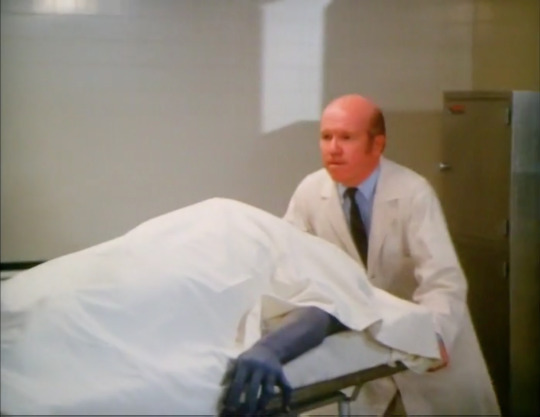
That's supposed to be a zombie under the sheet.
Lowlight
Pop : The Zombie returns to his nocturnal den in the junkyard by bus!
Nobody bats an eyelid, and from Carl's vantage point riding on the back bumper he looks like he could pass for a living person... yet when we next see his skin looks like melted cheese and he is clearly very dead. Inconsistencies like this kill any tension the episode was trying to build.
Tim : The criminal underworld’s characters do feel a little too stereotyped, but it’s not as much a deal breaker as the Zombie itself. While we barely see it, when we do it’s.. mixed. During the morgue scene, it’s represented by a healthy arm and feet painted with blue food colouring under a white linen sheet. The way it looks; it might be one of the Blue Man group under there. If they existed in the 1970s. Which they didn’t.
Updyke vs. Kolchak
Updyke doesn’t appear in this episode - so it’s still 1-0 to Kolchak on aggregate.
Score on the doors
Pop : It’s a bit half baked, but still has some Night Stalker magic 4/10.
Tim : An episode that was still working out what it wanted to be pretty much to the end. 3/10.
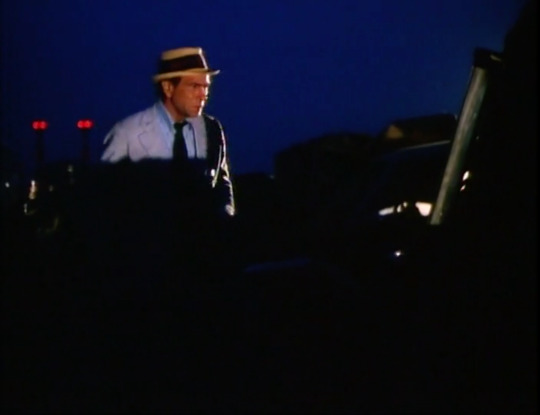
As the old adage goes; if you need a zombie taking care of, you're best off doing it yourself.
#afg#antiquesforgeeks#kolchak: the night stalker#carl kolchak#kolchak50#the night stalker#AfG Kolchak 50#Youtube
0 notes
Text
Kolchak : The Night Stalker at 50 - The Ripper
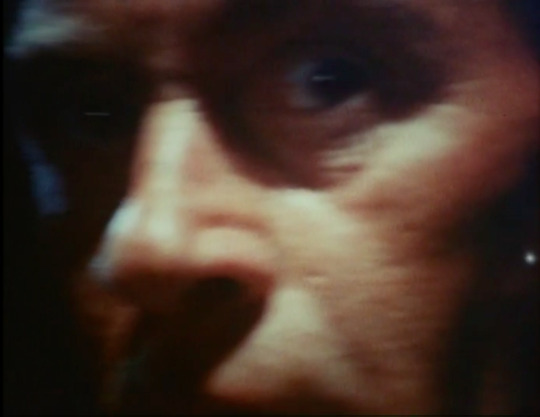
One of our favourite shows is 50 years old today.
About thirty years ago, Friday nights were a different experience; some of the school year diligently did their homework, avoiding having to do it on Sunday night. The cool kids were down the park; the local teenage boys trying to woo the local teenage girls with cheap cider from a corner shop whose proprietor would incessantly complain about the crumbling moral fibre of society, yet whose only check for the suitability of the cigarettes and alcohol he sold to his juvenile customers was their ability to pay.
Then there were those who were glued to the TV, who fell in love with early evening comedy, talk shows, late night news analysis and cult films starting not long before midnight.
Guess which ones we were?
Around the autumn of 1991, a series of late night cult TV started on BBC 2 in the UK. Called The Mystery Train was presented by Richard O’Brien (he of The Rocky Horror Show and Crystal Maze fame) and came in three parts. A serial, a film (usually a 50s sci-fi / schlock horror flick) and a short. Much like the Saturday morning matinees at the cinema my Dad used to tell me about.
The serial that was chosen for this nighttime smorgasbord? Kolchak : The Night Stalker.
Fronted by Darren McGavin reprises his titular role of Carl Kolchak (or Karl depending on the week's writer) from the earlier TV movies, it continued the adventures of the old-school newshound whose stories always seem to end up taking him into the world of the paranormal, shadowy government conspiracy, corporate shenanigans or scientists who unwittingly have unleashed far more than they expected.
To keep him in check, as much as Kolchak can be kept in check, Simon Oakland also returned as his long suffering boss, Tony Vincenzo.
The show has been seen as the progenitor of the X-Files, but it’s really better. Yes, it is rather “monster of the week” at its core, but Kolchak’s conceit is better than either Mulder or Scully. Plus, it’s unencumbered by a story-arc that has to be periodically shoe-horned into the show.
With hindsight the show really sat well with The Mystery Train’s eclectic vibe. Funnily, for a while neither Pop nor I knew the other was watching the show; but once we found out, Monday break and lunchtimes at school were a breathless analysis of Friday’s episode. Those who had missed it, or worse still didn't care, obviously shrugged their shoulders and left us to it.
Analysis might be stretching it a bit far. More a mix of piss-taking at the quality of the special effects, the flatness or excitement of that week’s story or marvelling at certain shots and the atmosphere they managed to create.
Siskel & Ebert’s jobs, no doubt to their relief, were safe.
Why bring this up now? Well, exactly 50 years ago today, the 13th of September 1974, Kolchak : The Night Stalker began airing in the US at 10pm, on ABC with the Episode The Ripper.
The show only lasted a season, and a shorter than intended one at that, but it has cast a very long shadow.
Plot

The Ripper strikes. It's about to go down.
Quite straightforward this one. A series of murders in Chicago has similarities with those committed in Whitechapel, London during 1888. No-one other than Kolchak can - or is willing enough to - suspend belief and put the pieces together to do what is needed to stop the killer.
Guests
Darren McGavin and Simon Oakland were joined by :
Beatrice Colen - Jane Plumm
Ruth McDevitt - Elderly Woman
Jack Grinnage - Ron Updyke
Ken Lynch - Capt. Warren
Marya Small - Masseuse
Donald Mantooth - Policeman
Robert Bryan Berger - Mail Boy
Roberta Collins - Detective Cortazzo
Clint Young - Driver
and
Mickey Gilbert as The Ripper
The Scoop
Pop : I haven't watched this series for many years, but this one feels like it hits all the beats of a 'typical' Night Stalker episode.
Carl Kolchak stalking a supernatural fiend, mostly at night, to get a juicy story.
Police officers being thrown about by said fiend.
Some banter with an exasperated Tony Vincenzo, Carl's boss at the Independent News Service.
Light piss taking of Ron Updike, a rival reporter.
Footage of a Chicago 'L' train passing through the city (you're going to see this clip a lot!)
Since it's the pilot, that all makes sense, but it also exposes one of my main issues with this series - it's very much like a smaller scale, less impressive version of the 2 highly successful feature films, which many original viewers were likely to have seen first. Still, taken on its own merits it's a decent pick for a pilot. And just to be clear, I'd definitely count myself as a fan of this series.
Just like the films, it's all very darkly lit. Although it reminds me a little of the critique of 'Manos, the hands of fate" in MST3k - "Every frame of this movie looks like someone's last known photo!", in my opinion, the lack of light in many of the scenes only adds to the creepy atmosphere, and helps to disguise cheap sets and costumes.
There is a decent amount of outdoor footage, and pacing is also good for a show of this era. This is the pilot, so I'm interested to see if that continues!
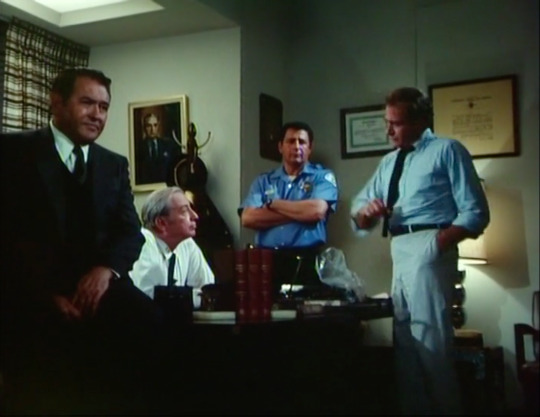
You won't catch him like that. Our hero holds court to an exasperated Vincenzo and an indifferent Police Captain, who's about to get his arse handed to him.
Tim : This could so easily have been a rejected script for a third Kolchak film and yes, it does feel a little rushed in places, but the script does a good job of reintroducing the Kolchak/Vincenzo dynamic to an audience who would not have had the luxury of pulling up a streaming service and re-watching the preceding movies.
It also pretty well sets up the character of Ron Updyke and his, albeit one-sided, rivalry with Kolchak. Jack Grinnage and Darren McGavin were good friends, which is immediately obvious from chemistry.
The tension and tone of the show is established quickly in the opening shots and maintained. Part of this is down to the theme by Gil Melle, part to the incidental music; that moment you hear the series theme and its flip from gentle to menacing half way through. Coupled with some really lovely cinematography, even if by modern standards, sometimes feels a bit shonky.
What the episode doesn’t do well is as obvious as what it does - away from the leads and the characters of Updyke and Captain Warren (Ken Lynch), there is a very real feeling that everyone else is wallpaper, only there to move the story forward to Kolchak’s next checkpoint.
Overall though, this was one of my favourite episodes back in the 1990s and on rewatching it didn’t disappoint.
Highlight
Pop : I love Kolchak's freak out when he's hiding in the ripper's wardrobe and is about to get caught. Darren McGavin really does give his all to sell this series, and his performance perfectly walks the line by treating the material just seriously enough to avoid undermining it.
Tim : Agree the wardrobe scene is a key moment, but the chase between The Ripper and Police is an exciting, if sanitised for 1970s US network TV, action scene that feels larger than the budget. The lighter, more comedic moments with the Independent News Service staff and the Police land well too, providing just enough of a counterpoint to the show's horror, to avoid seeming silly.
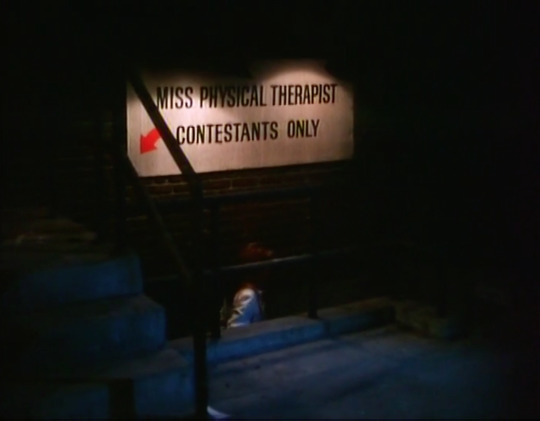
"Miss Physical Therapist" in a Ripper story. Uh-huh. Right. "Contestants". Gotcha.
Lowlight
Pop : The ripper himself has no character - he's a silent killing machine.
He also manages to keep his Victorian era suit and cloak perfectly intact through decades of gruesome murder. Perhaps his clothes are also supernatural?
Tim : Jane Plumm’s given a raw deal in this episode; the way she’s introduced, you’re immediately made aware she’s a one dimensional. disposable character defined largely by her physique.
Score on the doors
Pop : I'll give this one 7/10.
Tim : Solid. 8/10.
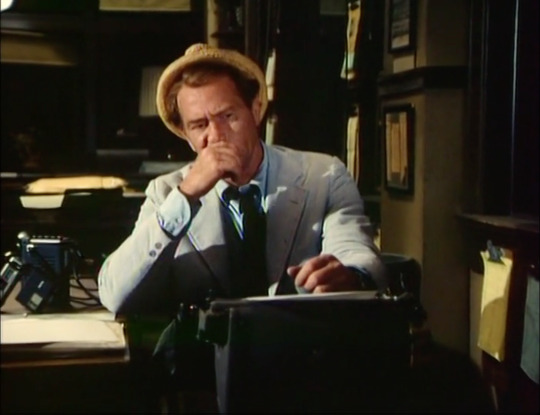
How can you explain it? Who could explain it? Who'd believe it? Carl ponders if his story will ever fly.
#afg#antiquesforgeeks#kolchak: the night stalker#carl kolchak#kolchak50#the night stalker#AfG Kolchak 50
1 note
·
View note
Text
Games of Christmas Past : Winter Games
US Gold/Epyx / 1985 / Originally £9.99 (£14.99 disk) / Commodore 64
Ding-dong-merrily-on-high, it’s another round of Christmas games on Antiques for Geeks! It’s been a while! Hope you’re well! Pull up a seat and let us tell you all about the games you couldn’t avoid owning, even if you wanted to!
Over to Tim...
Oddly, Christmas was not a rich vein of games for me. Whilst each year, festive editions of Zzap! 64, Commodore User or Commodore Computing International would tantalise with reviews for me to read, the games featured in them were not as readily forthcoming in the form of presents. No, as gifts, anything computing related would favour hardware purchases and whenever there was software bought, invariably it would be productivity titles. I think I was the only kid in my class that Santa decided needed Kindwords 2 for the Amiga in 1989.
Yes, while I was given the gift of word processing, everyone else was getting into Batman.
This time of year wasn’t a complete dearth of fun however. 1987 stood out as a vintage year; on Christmas Day morning that year, as it resolutely refused to snow outside, I unwrapped a compilation from US Gold. Solid Gold contained five of the publisher’s best-selling titles from the previous two years and offered them for the same price as a new game. As we know, especially with US Gold, best selling doesn’t always mean good, but there wasn’t a dud in the selection. I could wax lyrical about the different titles [And he did. For months. -Meat] but there were two that stood out from the others. Gauntlet and Winter Games.
Winter Games had been released for the C64 by Epyx in America during 1985 and had sold very well. Putting this on a compilation for Christmas in 1987 meant another bite at the sales cherry, but the timing was also well observed. After all, 1988 was an Olympic year...
Unlike later titles published by US Gold, Winter Games had no official licencing in place. Instead of playing out the Olympics, you are officially playing out a fictional event that by pure coincidence, pretty much mirrors the real Winter Olympics sanctioned by the International Olympic Committee. Complete with opening and medal ceremonies. Coincidentally, it’s also set in Calgary, Alberta, Canada in 1988, which just happened to be the location chosen for that year’s actual Winter Olympics. What are the odds?
Yes, there is an opening ceremony; it’s a rehash of the one used in Summer Games, but that’s not a bad thing at all. Once the Olympic, erm, Winter Games flame is lit and doves released, it’s off to select your events.
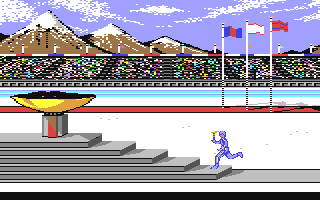
RELEASE THE DOVES!
Players can attempt all events, playing a combination of the seven events, just the one, or settle for practising. Generally, playing the game meant playing through all of the events. Winter Games is a heavy multi-load on the C64; in the US where a set-up with Commodore’s 1541 disk drive was ubiquitous this was irritating, but by no means, the end of the world. In the UK however, where most people used cassette, this was far more painful. Fortunately for US Gold, us Europeans didn’t know any better.
You can have up to eight players in one game; each can enter their name and select their country. In a nice touch, each player’s national anthem is played when selected; this is notably missing from the versions that were commissioned for the Spectrum and Amstrad CPC by US Gold. Personally, I always chose to compete under Epyx, mostly because it has a cool anthem and flag.
That done, it’s time to begin competing in the seven events...
Hot Dog Aerials
Freestyle skiing at it’s finest, each player has three attempts to combine different moves to try and impress the judges who score your performance much like you see in figure skating. There are ten points available and the aim is, of course, to get as close to the maximum on at least one of your attempts. All to a syncopating rhythm, that I always imagined was blasting out from behind the crowd for the benefit of the TV cameras.
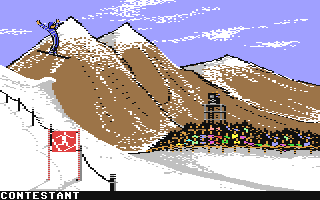
No, I’d never heard of Hot Dog Aerials before Winter Games, or after it.
This is far harder than it looks. Launching from a slope with some beautifully drawn mountains as your backdrop, it’s very, very easy to perform basic stunts and get a reasonable score in the seven and eight and half points. When you start combining stunts with flips, that’s when it becomes hard. Mix two flips and you’re into the solid nines - two flips in different directions will score you that magical maximum of ten points. However, time this wrong and you’ll end up in a heap of broken skis (and you’d expect, bones) at the bottom of the slope. Better to bank a simple combination guaranteeing you a score over nine points and then use your remaining two attempts to improve your score.
Biathlon
Although there is some competition for this, Biathlon is probably the strongest event all round in the game. The whole thing is incredibly pretty, split over three screens of cross-country skiing and a fourth in the shooting range. While this does involve a fair amount of joystick waggling (or destruction, if your joystick wasn’t microswitched), what is really nice is that this is not a matter of hammering away at the joystick as quickly as you possibly can.
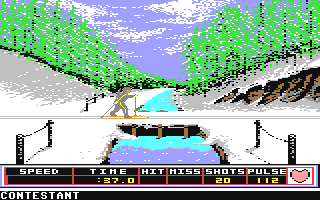
Doesn’t your biathlete look so snazzy in his grey unitard with yellow go-faster-stripe?
To master this, you need to build a steady rhythm to get the most out of the flats and climbs. Shooting is tricky, with you having to cock and load your gun with a back and forward flick of the joystick, then fire when the automatic crosshair is in location. Miss and there is a five second time penalty for each incomplete target.
The challenge of combining these three disciplines is hard and initially can be very frustrating, but time and patience is rewarded. If you’re really good, you can finish the event in around two minutes. If you were me, then doing it in under three was an accomplishment.
Speed Skating

Yeah, erm, not much to see here...
We’re now onto an event that is familiar to most; it’s a straight head to head sprint race against either the computer or your friends. There is more joystick waggling here and while it is a lot less subtle than the Biathlon, the key here is still rhythm to build and maintain speed. Go too fast, and the skater on the screen enters a kind of foetal position and does, well, nothing. This is a trap that is very easy to fall into and one that if you're playing against the computer, is punished as it does not make mistakes.
All said and done, this phase of the game is quite forgettable. That’s not because it’s bad, but because even in 1985 (and certainly in 1987) we’d seen this kind of thing over and over again. Sprinting in Activision’s Decathlon, sprinting in Daley Thompson’s Decathlon, sprinting in Summer Games. The looks also betrays its heritage - it could easily be the Rowing game from Summer Games II repurposed with new graphics. Coming after the visual feast of the first two events, it’s a bit of a let-down.
It all feels very transitory, almost like a mini-game to entertain you while another event loads. Even though it isn’t.
Figure Skating
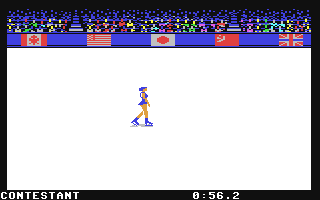
She’s beautifully animated, but that's where the excitement ends.
You have a minute to perform a programme of seven figure skating moves and score points. This plays out to a nice rendition of Tchaikovsky’s Waltz of the Flowers from the Nutcracker suite, with a skater making her way down an infinite rink. The animation of the skater is superb, much in the naturalistic vein of the player in Impossible Mission.
But.
I must confess, I never understood the attraction of this event. It was for me the second most boring event in the game. The jumps and direction changes look great when executed correctly, but for me it seems hard to get anything over a three out of six. But as much as I disliked it, others loved it and I can see that for some, it’s a challenge, rather than something to endure.
Ski Jump

Life comes down to a few moments...
Although I really like the Biathlon event, this was my absolute favourite. It looks stunning from the get-go, with a beautifully drawn side-on view of the ramp. The aim here is to control the jumper as skillfully as possible so that they can jump as far and as stylishly as possible. Timing is key to this event. You need to successfully launch your competitor off the ramp (if you fail, it ends with a comedic flump from the bottom of the ramp), then once in the air, the action changes to a view of the beautifully drawn landing zone and it becomes a matter of keeping your athlete at an optimal angle at all times. The game will try as it might to knock you off-course by having the jumper cross their skis, lean too far back or too far forward. The quicker you correct these problems, the more style points you score and also, the further you fly. If you don’t, then your skier ends up in a heap on the floor.
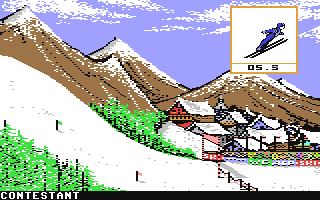
...and this is one of them.
Sounds a bit dull doesn’t it? But no. The whole thing has real atmosphere to it; the opening music is cinematic, inspiring even, with a thudding baseline that is just that little bit foreboding. Yes, it does bring out the nerves, the more invested in the game you become. I love the skill and reaction time required to make this game work and a good jump rewards you with a roar from the crowd. Turn in a really good performance with a roar and a fan-fare. What more could you want?
Free Skating
And from the sublime to the ridiculous. Another two minutes of skating induced tedium. A repeat of the Figure Skating game, albeit with funkier music and two minutes to do your programme of moves three times. Much like the saying about insanity, doing the same thing provides the same results; your skater jumps and pirouettes (or falls over) in the same way and an inevitable score of around three out of six is awarded.

You again.
This really is the low point of the game; unlike Speed Skating whose criticism is that it’s just a rehash of similar style events from other games, Free Skating manages to take all the frustration of Figure Skating and draw them out with the extra time. Beautifully presented, but painful to play.
Bobsled
The final event is a real white-knuckle ride. You control your bobsled down a run, trying to keep your speed up while ensuring you don’t crash. This is far easier said than done. You have no control over the braking of the sled and just need to make sure that you steer hard enough in the right direction to stop the sled from venturing too high up the sides of the course and wipe out.
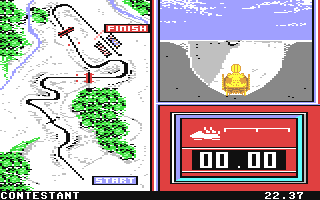
Despite the action really only taking place in the upper left hand corner of the screen, at no point does this compromise the experience. That says a lot about the playability of the event...
The forces acting on the bobsled are modelled quite well here, especially considering the computing power available and there is a really good sense of speed from both the graphics and sound.
Learning the course so you can anticipate the turns is vital to getting a good time. With just three attempts to run the course, knowing it inside out guarantees the best results. You see Bobsled drivers before a run with their eyes closed, visualising the turns they have to complete? Yes, that’ll be you.
If you’re playing on tape, you’re at a massive disadvantage here, as it’s the final event on the tape and locating it is a chore to play as a single event or practice. Although the same for all events, being the it is felt most acutely here.
Still, it was an event that I really looked forward to playing and a fair few times was a winner-takes-all high stakes affair as a gold medial here might just seal overall victory at Winter Games.
Medalling
In between each event you get a brief medal ceremony and if playing through the current overall standings. Unlike the events, this is a little bland and no doubt so you don’t have to load a bespoke medal ceremony after each sport. However, where something more substantial is missed most is at the end of the competition. It would have been great to have something more special and a closing ceremony (as was the case in Summer Games II), but here you have to make do with a ranking of players, a brief fanfare and the winner’s national anthem.
But in the scheme of things, this is a small gripe; when the games are presented so stylishly with beautifully fluid animation and a great musical score, you really can’t complain much. Epyx were one of the first companies that thought this kind of thing through - the graphics artists and sound designers worked alongside the software developers to produce a polished product rather than have them all work in isolation. Bear in mind also, that when developed in 1985, the do-it-all bedroom coder was still very much a thing. This approach was special.
For me and my friends, the game provided hours of entertainment; while perfectly possible to enjoy on your own, it really came into its own with many players. Given the different skills needed to compete in each game, there are players who could be terrible at one event, yet win the next. Interest doesn’t automatically wane, even with the skating events thrown in.
The game also sparked something else. Come February of 1988, much like the kids who run outside to play football after the FA Cup Final, I’d watch the antics of the athletes in Calgary at the Olympics on the TV, then hurriedly dig out Winter Games to give it another go. Even today I view the Winter Olympics with fondness, the 1988 event firmly imprinted on my psyche.
I may not have ever given ski jumping a go in real life but for a brief moment in the late 1980s, as the sun struggled over the horizon in the depths of a British Winter, Epyx’s game allowed me to soar like an eagle. Just like Eddie.
Eddie. Eddie ‘The Eagle’ Edwards. The British ski-jumper with the thick glasses. Yes, ski-jumper. The one they made that film about. What do you mean you’ve never heard of him?
Score card
Presentation 9/10
Epyx really pushed the boat out, even if they didn’t have an official licence. The whole package feels so consistent - from the player selection screen right the way through to the final medal table.
Originality 9/10
Though there were sports games out there, they were mostly focussed on summer sports. Winter sports, even today, are less well serviced.
Graphics 9/10
Hard to fault. The backgrounds are stunning, the player sprites fluid and well drawn. When it comes to criticism, we’re starting to come down to the way players prefer something to look, rather than thinking it looks bad. I know that I don’t much care for the way the speed skaters look, but that’s not to say they don’t look good to begin with.
Hookability 8/10
Immerses you so far you don’t even care if you have to sit through the figure and free skating events.
Sound 9/10
Great music, superb sound effects. It doesn’t have the work of the mighty Rob Hubbard, but to be honest, it doesn’t need it.
Lastability 9/10
This got played and played and played and played. Even now, it’s a go-to game on the Commodore 64.
Value for Money 10/10
Worth every single penny of the entrance fee.
Overall 9/10
Really hard to come to any other conclusion, even when taking into consideration it’s small faults. Epyx defined this kind of game in the 1980s, earning them their reputation and position as a well-loved developer. Had things worked out differently for the company, they might be on a similar scale to EA today, but hopefully without the loot boxes. I can’t help but wonder what would have happened; would have loved to have seen this series evolve over the years; Epyx Winter Games 2022 on the PlayStation 5 could have been epic (pun not intended).
Screenshots borrowed from Gamebase64 - playing this again for the review, I regressed to the junior me, became engrossed and forgot to take some screenshots. So kudos to them, and for spotting that the ZZap 64 review back in 1985 used screenshots from the Atari version.
0 notes
Text
Games of Christmas Past : Race / Spin-Out / Cryptogram
Philips (Magnavox) / 1978 / G7000 (Odyssey²) / sold with system
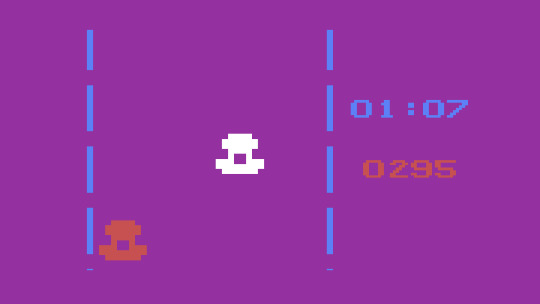
Ding-dong-merrily-on-high, it's another round of Christmas games on Antiques for Geeks! It's been a while! Hope you're well! Pull up a seat and let me tell you all about the games you couldn't avoid owning, even if you wanted to!
Ah, the console pack-in title. A perfect opportunity to show off what your new system can do. Would the Gameboy have been as wildly successful without the inclusion of Tetris? The SNES without Super Mario World? How about the Wii without Wii Sports?
Let me answer that for you. Yes, yes, and no.
Sometimes the quality of the included title gave a pretty strong hint about the blighted future of a new piece of hardware too. Who can forget the Atari Jaguar with the immortal Cybermorph? Imagine wrapping your mitts around the dinner-plate sized Jaguar controller in Christmas '94 to play that turkey...
I honestly can't remember if we received any extra games when we got our trusty Phillips G7000. The cartridges alone were expensive enough to be joint Christmas presents for my brother and I. Our household's greatest hits collection of Pickaxe Pete, Satellite Attack and Quest for the Rings have previously been covered, but what about that original system pack-in?
Well, that got lots of play too, despite being... well... a bit basic.
Like several other games on the system, the snappily titled 'Race / Spin-Out / Cryptogram' was actually 3 games in 1, selected using the number buttons on the machine's membrane keyboard. Atari pulled this trick too with some early VCS games, and though I don't know for sure who came up with the idea first I have a suspicion Phillips were copying taking inspiration from the market leaders. It's a solid idea; give the impression of value with a little compendium of games to get you started.
So, what about those games?
Race
A race against time - travel as far as you can before the two minutes are up, avoiding the competitor race cars. There is a time penalty for crashing.
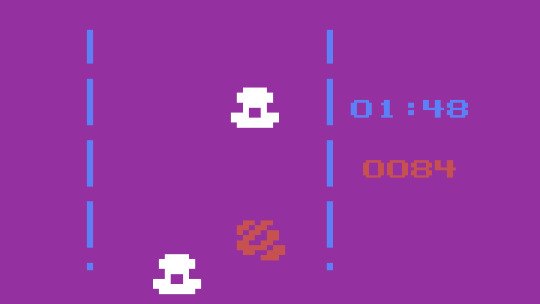
Boom! That red blob is the mangled wreckage of your car. No walking away from this one.
The first game sees you maneuvering your 'car' left and right at the bottom of the screen while a simple line animation represents a completely straight 'road'. There's a constant stream of other cars coming down from the top of the screen, and you have to try to weave past as many as you can in the fixed time limit to get a high-score. Hit another car and you explode, losing time. There are a couple of difficulty settings which dictate how fast these cars come at you. That's your lot! It's a really basic experience, with no variation. Even the pattern of the cars is preordained. Many early games had very simple mechanics, but this is really pushing it.
Spin-Out
Race your opponent round the corners and barriers of the Spin-Out circuit. Press the action button to go faster. The first car to complete a set number of laps wins!

A cyan track against a purple background. The 70's was the era of good taste.
Now this is a bit more like it. Assuming you have a second player to race against, this simple top down racer could almost be described as fun, despite being nearly as minimalistic as 'Race' was. It's no Super Sprint, mind you, with the cars instantly moving in the direction you point the joystick. There's certainly no representation of momentum or other fancy gameplay features. At least a couple of difficulty levels are available, dictating the speed of the cars and the complexity of the track.
Cryprogram
A game of knowledge and deduction. Type a word or phrase onto the TV screen (don't let your opponent see it). The letters of the phrase are then jumbled up, and your opponent must unscramble them (each correct letter remains on screen). The screen shows the number of mistakes made. The player who makes the least mistakes wins.
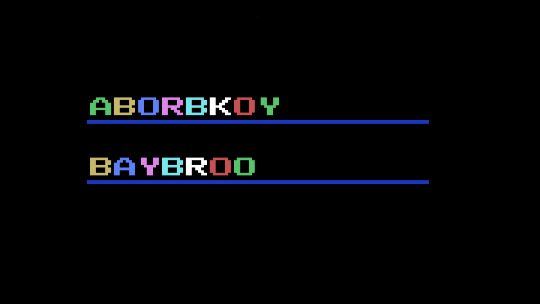
Need a clue? Uridium. Paradroid. Tim's favorite twitter feed?
Making sure to demonstrate the G7000's unique functionality to the kiddies, Cryptogram is a game better played on paper, where your mistakes aren't punctuated by an irritating beep and you don't have to bruise your fingertips on those unyielding 'touch sensitive' keys.
Commentariat
Pop
I was all ready to really dump on this one, but it's partially saved by the fact that even basic multi-player games can still be really fun. The crash mechanics of Spin-Out are pitiful, but it's still quite playable despite itself.
Race is rubbish, though, and I'm mystified at the memory of playing and enjoying it. Despite it's seemingly obvious crapness, I recall playing this one a fair bit, and would sit, entranced, weaving through the traffic until the time limit was up. I suppose for a generation raised on Pong and game-and-watch games it counted as acceptable entertainment.
As for Cryptogram, about the only thing going for it is the ability to render a 'fuck' or 'cock' on the family TV in vibrant colour, a pleasure I was denied by virtue of being a tedious little goody goody. It was certainly the least played of the 3 offerings here, being barely a game at all. But, y'know it was educational. Who's to say what my reading age would have ended up without it?
Meat
I have a 'Cryptogram' for you. SHTI.
Score card
Presentation 4/10
In-game presentation is the very definition of bare bones, though to be fair that covers most games of this era. There are no introductory screens or music. Like all G7000 games, it comes in a sturdy plastic box, and also has appealing watercolour cover art to help get you in the racing mood.
Originality 2/10
Consists of inferior rip-offs of games like Sega's Monaco GP and Atari's Sprint, alongside a version of a pen and paper game as old as... pen and paper? That these don't play exactly like their inspirations is probably mostly due to their extreme simplicity.
Graphics 2/10
Even for the machine, these are basic and characterless. The cars in Race could be almost anything, with no animation present at all, and the sensation of movement amounts to some white bars moving from the top down to the bottom of the screen. The race track in Spin-Out is made solely from straight lines. No curves. At least the cars actually can visibly 'spin out' in this one, even if it looks laughable. Cryptogram is just multi-colour letters displayed on the screen, something the G7000 was born to do.
Hookability 4/10
These games are easy to pick up, and you won't need much instruction to get going. If things get competitive you could find worse ways to spend your time than a few laps of the track in Spin-Out.
Sound 1/10
BrrrrrrrrrrrrrrrrrrrrrrrrrRRRRRRRRRRRRRRRRRRRRRRRRR BOOM! BrrrrrrrrrrrrrrrrrrrrrrrrrRRRRRRRRRRRRRRRRRRRRRRRRR BOOM! BrrrrrrrrrrrrrrrrrrrrrrrrrRRRRRRRRRRRRRRRRRRRRRRRRR BOOM! BrrrrrrrrrrrrrrrrrrrrrrrrrRRRRRRRRRRRRRRRRRRRRRRRRR BOOM! BrrrrrrrrrrrrrrrrrrrrrrrrrRRRRRRRRRRRRRRRRRRRRRRRRR BOOM!
Aural torture.
Lastability 5/10
A real mixed bag. You'll get bored with the single player only Race after a couple of goes. With 2 players, Spin-Out is definitely much more worthy of your time. While no Mario Kart, you could potentially be having some fun with this months later. Even thinking about Cryptogram bores me. They must have had some left over cartridge space to fill.
Value for Money 7/10
Can't really fault it here, since no more money changed hands. This a a decent effort for a late 70's games console, giving the new owner 3 (let's be honest and say 2 and a half!) new games to try.
Overall 4/10
Context is everything for this one. Whilst not as as good a multi player pack-in title as Atari's Combat, this is decent fare for the year the G7000 launched. It really doesn't hold up to later Atari pack-ins like Space Invaders, but Phillips's machine was fundamentally limited and quickly left behind on many fronts. With better and more characterful implementations of similar ideas on other classic gaming consoles, this is one title best left for Christmas past.
Want to have a go anyway? Play it here.
0 notes
Text
Games of Christmas Past : Goldeneye 007
Rare / 1997 / Originally £59.99 / Nintendo 64
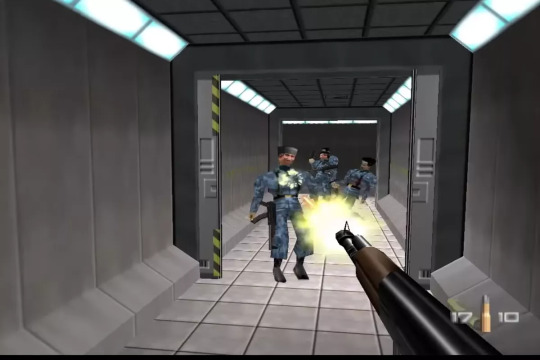
As the sun sets on this strangest of years and a cold wind blows through an empty AfG towers this Christmas, the team cast their thoughts back to Christmas Days past, when your rich Uncle used to come round in the afternoon with your cousins and their latest full priced games that you couldn’t play because they had an Atari ST in 1987 and you were still pretty pleased with your Spectrum +2 bought last summer thankyouverymuch.
So once again, we’re looking back at the games we did get to play on Christmas Day. The good, the bad, the ugly, the over-priced, the cheap and the ones purchased by Grandma because the nice man in the shop said it was the one that all the kids were playing.
First for this year, Pop...
Now effortlessly installed as the most fondly remembered and critically lauded Bond game ever, the world needs another piece about Goldeneye like a donkey needs a second pisser... but I’ve been asked to write about a game that holds strong seasonal memories. There’s simply no way to avoid this bald fact: Goldeneye was simply the best gaming Christmas present I ever got.
So... I’m going to write about it... and some lucky donkey is going to empty its bladder in record time.
About the best thing about being newly employed in the late 90’s was having my own money to spend on whatever gaming rubbish I saw fit. I bought a Tiger ‘Game.com’, Satan's own handheld system. Why? Because it was there! (in the Argos catalog, that is).
So when I wandered into a branch of HMV and saw an N64 demo pod with the first level of Goldeneye ready to play I knew straight away that my number one seasonal priority was to be able to take it home.
The first level lays it all out. I stealthily approach a guard tower, taking out a few unfortunate soldiers on the way. Up top is a sniper rifle... plenty of time to get a bead on the forehead of a distant and totally oblivious soldier. He has no idea what’s coming. My finger tightens on the N64’s trigger button. He’s thinking about how cold it is... how much he misses his family... how soon his commission is coming to an end… to be back in his wife’s warm embrace... borscht for dinner tonight.
BANG! His head snaps back and he crumples to the ground… ‘Hey! That’s sick!’ opines some random guy watching over my shoulder. But I can hear it in his voice. He knows, just as I know. This game is awesome.
I gifted myself a few games on Christmas day along with the console. I’m sure Mario 64 was one of them, and I’m sure I loved that too, but that year the holiday season belonged to Bond.
I’d played some first person shooters before, but those had all been riffs on the ‘Doom’ formula, with a corresponding feeling that you were floating through the levels, somehow disconnected. Goldeneye put you right in the film, dealing with changing objectives and with the ever-present possibility of sneaking up on enemies and dealing with them silently. Many levels were designed around the film’s sets before shooting was even complete, and they benefit greatly from feeling more like real places.
And so much fun could be had just experiencing this world! Somewhat shamefully, Tim and I would play the second level set inside a well guarded Russian lab with our own rogue objective: the scientist cull. What this involved was simply finding all the white coated lab personnel and gunning them down in the most extreme (and satisfying) ways possible. The detail that made this particularly fun was how well their biological whites showed up the inevitable blood stains, like some kind of terrible alternative universe Persil advert.

Sorry, this lab is over populated. I’m sure you understand.
This was a game that could be enjoyed as a quick blast on the easier levels, but provided a genuinely rewarding structure for extended play on the harder difficulties. The bad guys were tougher, requiring you avoid combat where possible and to master the precise aiming controls to take them out with head shots. Additionally, the mission objectives were extended with interesting additional tasks, taking in much more of the level. As icing on the cake, beating the game on higher difficulties unlocks a couple of extra levels, which are both well worth seeing - especially the ‘Aztec’ level from Moonraker where you get to face-off against fan favorite bad guy Jaws.
I suppose I should at least mention the groundbreaking multi-player element. The N64 supported 4 players, and 4 player couch co-op would no doubt have been awesome if I’d had 4 controllers, a decent sized TV and 4 people to play against. The few times I managed to rustle up an extra to battle against were good fun, if imbalanced, because I never got to play anyone else who actually owned the game. Single player was where I spent 99% of my time.
Apparently many of the team that put Goldeneye together hadn’t worked on a major game before, allowing them to build it unshackled by the past. In many ways this sounds like a game that came good because of dogged determination and a series of lucky accidents. It certainly shifted the goalposts for what was expected of a first person shooter for console generations of games to come. The way games develop over time often appears to be a series of big bangs, followed by copies, iterations and enhancements. Goldeneye is definitely one of those seismic bangs, a huge success that other developers wanted a piece of.
Rare did it all again, and technically better with the release of Perfect Dark a couple of years later, and though I loved that game too, for me it didn’t have quite the same bombshell impact.
I guess this is the point where we should address the elephant in the room. Goldeneye, like so many games from its console generation hasn’t actually aged very gracefully. The graphics were certainly pretty great for the time, with a long view distance and excellent character animation. They really do look hopelessly primitive in 2020 though, and the controls feel slow and clunky. Not to mention that the N64 controller, so ahead of its time in the 90′s feels like an alien object to a modern player used to iteration after iteration of 2 stick gamepads for the last 20 years. It’s a real shame that licensing issues have prevented a cleaned up re-release (we’ll ignore the 2010 effort by Activision; it’s a characterless shadow next to the real thing).
So why does this game make me think of Christmas? Is it because many of the levels in Goldeneye are appealingly wintry? Maybe because a Bond film was an ever present pleasure for terrestrial TV viewers at yuletide in the UK?
Nope. This game basically lets you commit murder on a massive scale, again and again and again (oh, and those poor innocent scientists!) That hardly qualifies it as festive entertainment. It's probably just because a new console and a great game to go with it has been a staple requirement for so many of my Christmases. This was one of the greatest of all.
Score card
Presentation 9/10
The bond atmosphere is presented almost perfectly, from the iconic ‘gun barrel’ opening onwards.
Originality 9/10
Like nothing else released before, Goldeneye set a high bar that wasn’t matched anywhere during the N64′s lifespan... except by its ‘sequel’ Prefect Dark.
Graphics 8/10
Somewhat colourless, but very solid. The frame rate is acceptable for the time. The digitized faces of the guards looked great back then, but slightly ridiculous today. Animation, particularly the way enemies react to being blasted, is exceptional.
Hookability 9/10
The dam level is the prefect opener, giving you a chance to see what the game is all about. Play it on the ‘Agent’ (easy) difficulty and you can have a good time without having to be a dead eye with the manual aim controls. No game let you snipe an enemy from half way across the level before this one. Once you had, you were in for the long haul... or morally outraged.
Sound 9/10
Perfect music for a bond game, and a great accompaniment to the action. Gunshots, screams and other spot effects all enhance the action. No bad voice acting to spoil the effect.
Lastability 9/10
Loads of varied levels, each with new, interesting objectives when played on higher difficulty levels. Because the mechanics of the game were so good, it was fun just to pick your favorite level and just mess around or prefect your run. Then there’s the multiplayer...
Value for Money 8/10
£60 was an awful lot of money, but there aren’t many games that got more playtime.
Overall 9/10
One of the all-time greats, I can’t bring myself to mark it down just because the passage of time has been so unkind.
0 notes
Text
Game Review: Aliens
Electric Dreams / 1987 / C64
Also released on Amstrad CPC, ZX Spectrum, MSX and C16

With one eye firmly on Halloween, we’re going to review some games that used to make us breathe heavily, grasping our joysticks tightly in our sweaty palms...
Based on James Cameron’s sequel to the archetypal sci-fi body-horror Alien, Aliens is possibly one of the most panic-inducing games of the 8-bit era. It goes without saying that it’s hard to actually scare anyone on an 8-bit computer, unless blocky, jerky and flickery graphics bring you out in a cold sweat. What you can do, however, is force the player into having to make a series of quickfire decisions under stressful conditions, juggling resources and trying to keep order in the face of the impossible, like an air traffic controller in a power cut.
Aliens is played from a first-person perspective, and at first glance seems like a fairly simple game. You start in the middle of the operations room in LV-426, in control of Ellen Ripley and a team of 5 space marines who’ve been sent to find the alien queen and rid the base of her menace. You get a cross-hair, which is where your bullets will go. You can look around to the left or right, and you can step through a door to another room with a press of the space bar.
Nothing much is happening right at the start of the game, but don’t worry, it won’t stay that way for long!
The queen sits in a room right in the depths of the base. You use the keyboard to select individual team-members, but you can only directly control one at a time. Each member is represented by a nice little image and a stat bar showing how tired they are. There are no practical differences between each team member, which is a bit of a wasted opportunity, but the images are still a nice touch if you’ve seen the film, and help the player identify with their soldiers. Your team grows weary if they move too far without a rest; they’ll be unable to move and will aim more slowly until given time to recuperate.
You can issue orders for any team member to move a number of rooms in any compass direction, and they’ll carry out your instructions to the best of their ability once you switch out. On the way you’ll encounter alien warriors, eggs and face huggers... or they’ll encounter you as they’ll actively try and hunt down your group.
When one of your characters is in the same room as an alien you’ll hear a warning noise. This is a sinister beeping when you’re not controlling the character directly, and a panic inducing klaxon when you are. What ensues next is a desperate fumble to find the correct key to select the character who is in trouble, followed by an anguished pan around the room in search of the invader. Obviously you’ve only got a limited time to do all this, and the warning tone gets quicker and increasingly agitated to make sure you’re well aware of this fact.
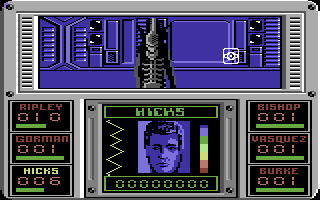
I see you!
Once you spot the alien, you’ve got to line him up and blast him before he gets to you. One head-shot should do it, but you won’t get a clean shot, because by now your heart rate is sure to be through the roof. He’ll run right at you too, making you waste a bunch of (limited!) ammo on him.
If you’re super lucky, several team members will be attacked at the same time, which is probably more tense than doing a driving test naked with a wasp in the car.
If the alien gets you the warning tone will change to a forlorn peep. That signifies your character being bundled up for immediate xenomorph oral impregnation. You’ve got a short time to get someone else to the room to take the alien out, but if you don’t get there in time you’ve lost them for good. Their little picture will disappear and you’ll get nothing but static if you switch to their screen.
Another nasty twist: if you blast an alien in front of a door it’ll leave a pool of acid blood which will kill your character outright should they try to exit that way.
There are a few things you can do to keep yourself alive. You can shoot out the control panels next to any door, which will prevent aliens coming through for a time. This is a one-time only deal, because you’ll have to blow the door open if you want to use it again. You can also re-stock a team member’s ammo at a specific room in the complex. This is useful, because running out of ammo is as good as a death sentence. You’ll also need a map. There’s no in game map provided, though the room number each character occupies is shown next to their image. The full price release provided a fold out map in the box, and you’ll need this. Make sure you have a copy handy, because the game is almost unplayably hard unless you have one!
One last thing. The aliens spread a sort of fungal growth around the rooms, which can cover doors and must be blasted away. There’s a generator room somewhere in the complex, and if the walls there get covered by alien fungus the LIGHTS WILL TURN OUT!
I can’t emphasise enough what bad news this is, because hunting for aliens by shadows alone is probably about as much fun as falling into the sharps bin in an STD clinic.
Film licenses had a pretty bad reputation for the discerning 8-bit gamer, tending to be shoddy and quickly thrown together efforts. Aliens is both an excellent game in its own right and perfect at evoking the tension and atmosphere of the film. There’s also quite a bit of tactical depth here too. Do you keep your group of soldiers together? Move as quickly as possible to the queen chamber? Maybe try to fan out and secure the generator room and armoury?

Ripley is looking a bit off colour today.
It’s also worth mentioning that there was also another Aliens game released for 8-bit micros, developed by Activision in the U.S. This takes a different approach to the license, presenting the film as a series of mini-game levels such as landing the drop-ship, fighting your way through the base to save Newt, the last surviving colonist, and the climactic one-on-one mechanical loader duel with the alien queen. This is also a good game, and well worth seeking out if you're a fan of the franchise, though for my money not quite as well conceived and executed as the U.K. version.
Playing it today
If you don't want to follow the obvious route of emulation and you’ve got a real C64, Amstrad CPC or Spectrum to hand, this should be easy to pick up for a few quid online. If you fancy something slightly more polished, there’s a fine looking windows PC remake ‘LV-426’ by Derbian Games that can be downloaded for free.
Commentariat
Tim: Ah, Aliens. Back when the franchise was actually scary and not a pastiche of itself.
As I suspect many others, I bought this on budget when it appeared on the Ricochet label from Mastertronic. This release really lacked the one thing that helped gameplay. A map.
The full price release had pull-out one included with the game; Mastertronic however, probably decided that including a separate sheet for just one title would have cost too much. And been yet another inlay for the staff at Menzies in the Clydebank Shopping Centre to lose. Zzap 64 published one for those of us without, but as I didn’t have that issue, I was in the dark. Quite literally, as it was more fun to play with the lights off.
Life is too short to make maps, so instead I ended up creeping about the complex, not really knowing where I was. Sounds dull, right? Well, no. The game oozes atmosphere; the graphics are tight and well executed, and though the C64’s SID chip is hardly taxed, the sounds that are there do the trick. The throbbing noise when an alien approaches, your exhausted marine out of ammo but still you frantically pull the trigger of their Pulse Rifle in the vain hope that maybe, just maybe there will be one last shell in there to give you a fighting chance. What I particularly like though is the freedom of gameplay, choosing to use your team as individuals or cooperatively as squads, investigating the different parts of the base separately. Pretty cool, when you consider it’s all done in just 64k.
Do I have fond memories of it? Yes. Would I play it again? Absolutely.
Meat: This game is an intense experience, likely to elicit some strong swear words if you’re not in the right mood for it. It’s certainly engrossing stuff though, and tough to beat. One thing though. Which genius decided that the ‘m’ key should restart the game? You know, the one next to the ‘n‘ key you use to tell your soldiers to move north? Nice one.

Pop: I played this a few years before seeing the film, but in retrospect it’s a very clever use of the license. It was also a really tense experience for an 8-bit game, particularly later on when your soldiers are assaulted by wave after wave of aliens and face huggers. Like many games of the era, it’s perhaps a little arcane for today’s audience, what with having to use the keyboard to select the different team members, but still playable and still enjoyable today. It’s the kind of game I can imagine working perfectly on a VR helmet, though that might be a little too much immersion for comfort!
Strangely enough, one of my strongest memories of this game was actually waiting for it to load off cassette tape. The Mastertronic re-release copy I played (borrowed off Tim, of course!) had a neat game of space-invaders that you got to play while waiting for the loading process to complete, accompanied by some very atmospheric music. This ‘invade-a-load’ appeared on a few C64 tape games, but in my head it’s always tied to playing Aliens.
Score card
Presentation 4/10
Very basic indeed. No intro screen, title crawl or music. The box contained a map, which is essential and should have been a part of the game itself.
Originality 8/10
An extremely novel use of a film license. The mix of first person perspective, team management and light strategy elements put this in a class of its own. Sadly, most licensed games of the 8-bit era tended to use cookie-cutter gameplay which was usually executed better elsewhere.
Graphics 7/10
Very clear and atmospheric, you’ll have no problem working out what everything is. The images for the team members are well drawn and clear for an 8-bit system. On the down side, rooms are drawn predominantly in a single colour and a little more variety in the room designs would be nice. The aliens walk like they’re going for a relaxing afternoon stroll, but the animation when they rush your position is very effective.
Hookability 7/10
Immediately intriguing, but the use of the keyboard and advanced controls for commanding team members require the investment of time to enjoy.
Sound 3/10
Played in near silence, except for gunfire and the alien warning siren. This actually makes the game more atmospheric. A title tune would have been nice.
Lastability 7/10
A decent challenge, it seems impossible until you form a good plan on how to tackle the assault on the base. Like many other games of the era, how much you get out of this game depends on how much you’re willing to put into working out how to play it effectively.
Overall 8/10
A fine example of how to compress the tension and drama of an action film into 64K.
2 notes
·
View notes
Text
Game Review: Beyond the Forbidden Forest
Cosmi / 1985 / C64
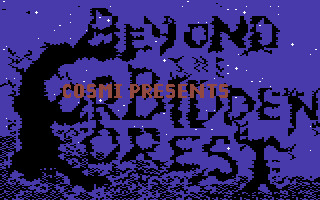
‘An archer took a stroll through the deep dark wood…’
With one eye firmly on Halloween, we’re going to review some games that used to make us breathe heavily, grasping our joysticks tightly in our sweaty palms…
Beyond the Forbidden Forest starts dramatically with flashes of lightning against a starlit sky. With every flash comes a crack of thunder from the C64’s SID sound chip, before the title of the game is revealed against the darkness. It’s obvious even at this point that the game's author, Paul Norman, was aiming for something much more cinematic than the average computer game of the era.
You start, alone, in an overgrown forest. You are an archer, sent to slay the dreaded Demogorgon, who legend says can only be killed by a golden arrow to the heart.
Your character occupies the middle of the screen. You can walk through the forest to the left and to the right. You can also walk into and out of the scene. Sometimes trees or bushes can obscure your view. There’s a primitive parallax scrolling effect so that the trees in the foreground move more quickly than those in the background, which could charitably be described as decent for the time.
There’s nowhere to actually ‘go’ in this game, and the forest isn’t there to be explored. You’re not really alone, you see. This forest is actually the scene of a desperate fight for survival.
The first creature you encounter is the scorpion. The scorpion will enter from the side of the screen and will rush straight at you. Like all this game's enemies, he gets his own special musical theme that plays during the encounter. This is where you run away! If he reaches your archer he’ll messily jab your organs out with his stinger, to the accompaniment of a kind of musical shrieking noise generated by the SID. Imagine something like a primitive version of the score that plays in Alfred Hitchcock's ‘Psycho’ when Janet Leigh gets stabbed in the shower. This game doesn’t pull any punches for its death scenes, that’s for sure.
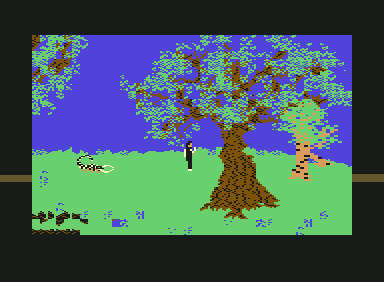
It’s behind you!
Luckily your archer can defend himself with his bow. Hold down the fire button and you’ll stand in place, aiming around the scene. A grey indicator bar moves up and down showing the elevation of your shot. Simply let the fire button go again to let loose an arrow. As you might imagine, it’s hard to keep away from a scorpion who is intent on perforating your innards while also stopping to pepper it with arrows, but this retreat, aim and fire mechanic is all a part of the game’s charm.
Plug the scorpion a few times and you get presented with a golden arrow, which appears from a spinning orb after an overly long fanfare plays. These golden arrows are important; you need to collect at least 4 to progress to the next stage of the adventure, and they also act as your ‘lives’. Every time the archer is killed you lose half of the stash of golden arrows, until the game is over. You will get very tired of hearing the victory fanfare, I assure you.
The next foe you meet is a massive worm, who rises out of the ground at various places in the foreground and background. Let him rise too many times without hitting him and he’ll swallow you whole, reappearing to regurgitate the bow, along with a healthy fountain of archer blood.
After that is a giant mosquito, who darts around the sky. He only takes one hit, but is tricky to get a bead on. He’ll drink your juices like a milkshake if he gets a chance, leaving only a crumpled heap on the forest floor.
Last up is… some kind of demonic frog / crocodile thing… who’ll jump about unpredictably and will mash your body like a pub piano at closing time.
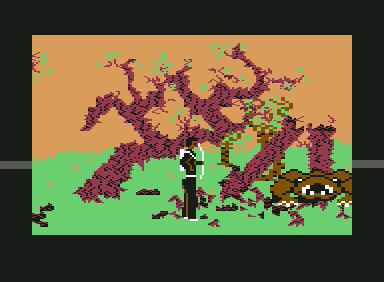
He’s hungry for your offal.
One nice touch is the way that the game shows the passage of time in the forest. The sun sets, and eventually night comes, with the colours of the trees and sky changing appropriately. The day to night cycle welded to the ability to move in and out of the scenery prompted Cosmi to market this game as having ‘OmniDimension 4D`. This was sadly typical of the shameless bullshit marketing departments would churn out in the 80’s.
Once these 4 different foes are defeated, it’s back to the scorpion again, in an effort to gather enough golden arrows for an assault on the caverns, which lie... beyond the forbidden forest. See? Although 4 arrows are technically enough to progress, you’ll want more than that to have a realistic shot at what comes next. To progress to the caverns, you have to to pause the game with F1 and then press F3. If you don’t do this the forest encounters repeat until you die or your patience runs out.
Once within the caverns you face off against 3 final foes.
The Bats: A group of bats flutter around the cave. One of them is a golden colour, and that’s the one you need to shoot. You only need one hit, but it’s flight is fast and unpredictable.
The Hydra: This four headed monstrosity fills the entire screen! Each head can shoot fire, and you’ve got to dodge about to land a hit on each one. Succeed and he’ll stop moving and turn to stone.
The Demogorgon: Squatting over a pit, this massive beast follows your movements with his head, shooting deadly bolts from his eyes that will disintegrate you instantly. Shoot him in his glowing heart to win the game and free the land from his evil!

I appear to have misplaced my skin.
Beyond the Forbidden Forest surely must be the most ‘‘Commodore 64ish’ game of all time.
Chunky blocky graphics? Very. Lots of muddy browns and muted greens? None muddier. Bone rattling soundtrack courtesy of the SID chip. All present here.
It was also creepy, atmospheric, and with all the sudden and violent deaths, really quite nasty… for a computer game of the 80’s at least.
Trivia
This is the sequel to ‘Forbidden Forest’, which is probably a bit better known and generally held in slightly higher regard (even by the game’s author). There was a third game in the series released in 2003 for Windows PC. It’s a third person 3D effort, which sadly looks pretty generic and uninteresting. There aren’t even any gory death scenes!
Playing it today
Only released on the C64, and copies are getting rarer. Easily emulated, but bear in mind that the function keys are important on this one.
Commentariat
Meat: This game could be the poster child for anyone who considers C64 graphics to be dull and unappealing, but behind the ugly front there’s a lot to admire here. The ‘gore’ is also hilarious! With the notable exception of the head chopping in Palace Software’s ‘Barbarian’, games of the era were very timid in their depictions of graphic violence. I guess this is about as close as we were going to get to a survival horror game in the 80’s...
Pop: I got this one on a magazine cover tape, and was immediately hooked on its strange atmosphere, shocks and gory death scenes. I was a latecomer to the C64, and by that point these graphics really looked like a dog’s dinner. Despite that I still found myself playing this game quite a bit. Aiming the bow at enemies in the foreground and background feels a little tricky initially, but it can be mastered. My main issue now is how long the player resurrection and golden arrow presentation scenes take. Skipping repetitive cutscenes was a luxury you were so rarely afforded in those days.
Sadly I never went ‘beyond’ the forest, because I didn’t have a clue that the keyboard was required to progress to the next stage of the game.
Score card
Presentation 8/10
Starting with the fantastic cinematic introduction screen, this is a game that goes the extra mile to involve the player in its world. There’s even a proper ending sequence with its own musical theme. The various versions of box artwork are all, however, distinctly amateurish.
Originality 8/10
Made before all games started to look and feel the same, this is obviously the work of a single individual. It doesn’t look, sound or play like any other game of the time… except perhaps for its own prequel.
Graphics 6/10
Undeniably ugly, blocky, untidy and muddy. Also somehow atmospheric and appealing. The screen filling hydra is a pretty impressive piece of work for the time. Gets an extra point for splashing the pixelated claret about.
Hookability 7/10
From the first moment the scorpion scuttles over and messes you up with its stabber you’ll either want to see what other horrible fates await you in the forest… or switch the computer off in disgust.
Sound 9/10
A series of memorable tunes, played by the C64’s SID chip in the style of a demented horror film organ. Though it’s somewhat crude, few soundtracks at the time were better suited to the on-screen action.
Lastability 7/10
It takes some time to get used to hitting the different foes with your arrows, but there are ultimately only 7 different types of enemy to face in this game. Despite that, it puts up a decent challenge, and you'll want to make it to the caverns to see what horrors are lurking in the darkness.
Overall 7/10
A game with plenty of quirks and flaws, which it overcomes by sheer force of personality.
1 note
·
View note
Text
Game Review: Dragon Buster
Namco / 1985 / Arcade
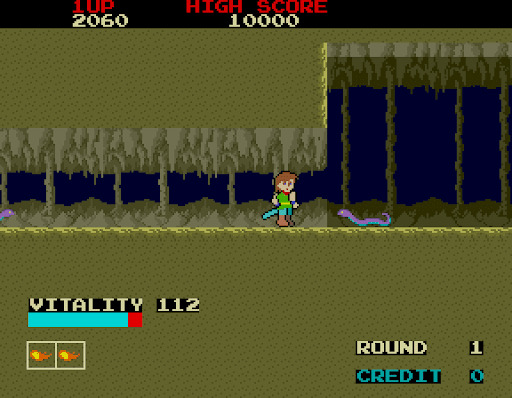
Guide hero Clovis on an epic journey to rescue Princess Celia, who is being held captive by a fearsome dragon deep in its underground lair. Fight your way through five different treacherous locations on your way to the fair maiden and glory!
I was looking for my brother who had wandered off on a trip to a local seaside town. Seaside towns were exciting for a number of reasons. The beach. Ice-cream. Cheap plastic toys. But chief among them for me was the opportunity to check out and play the latest arcade games. My brother was generally as excited at finding these games as I was, and so it was no big surprise when I finally caught up to him in a café transfixed by a glowing monitor in the corner. The game in question was one neither of us had ever seen before, or would ever see again… Dragon Buster!
Sigh... here’s yet another obscure little coin-op that I somehow remember in place of more meaningful things that may have happened to me as a boy…
I’m not sure exactly what it was that grabbed me about Dragon Buster, but it has a fair bit in common with other games I enjoyed much later on like Wonderboy in Monster Land and Zelda II. It’s kind of an early prototype for side view action games with lite RPG overtones. In many ways the game is more reminiscent of something you’d play on a home computer, with a level of choice and exploration completely lacking from the majority of arcade titles in ‘85.
Firstly, you get a kind of overworld map screen where you can choose your route to the dragon’s lair that ends each stage. OK, it’s hardly open-world exploration, but you do get the opportunity to choose a path with your preferred locations to fight though.
There are a mixture of five basic location types before your face off with the fire breathing princess-napper.
The Cave. A simple set of rooms and corridors in a straight line.
The Tower. Set over many floors, you’ll have to travel by ladder to find the way out.
The Boneyard. A spooky ossuary filled with winding tunnels where you’ll meet skeleton bosses at every turn.
The Mountain. Lots of descents down pits as you travel to the bottom.
The Ruins. A mix of bits from the other locations.
You also have a single life with a heath bar, which was a pretty unusual feature in the instant death world of the arcade. This makes the game feel fairly generous, at least in its early stages. I have also read that this was the place that the idea of a ‘double-jump’ was first introduced (where you can make a second jump while still in the middle of the first). The jumping mechanics are, however, notably poor here, so it’s possible this may not even have been an intentional feature.
Once you enter a location, Clovis is often presented with multiple corridors and ladders in search of an exit. As you explore you’ll uncover rooms containing mini-bosses that, once defeated, will drop either a useful item or reveal the way back to the overworld.
The rooms in each location are dimmed out before you enter them, like you’re walking in on a surprise birthday party... with a tough wizard or skeleton as the lucky birthday boy or girl. It’s quite a pleasing effect that seems stolen from a more serious role playing game. The items you pick up here can be the difference between making it to the next set of levels or expiring down in the depths. They include heath restoring potions, improved weapons, a mushroom that increases the length of your health bar and fireball spells that you can shoot at enemies. The fireballs can be stocked up for later use and have been given their own dedicated button. After exiting every location a chunk of Clovis’s health bar will refill.

Shakedown. Breakdown. Takedown. Everybody wants into the crowded line. Breakdown. Takedown. You're busted.
Once you get to the dragon’s lair at the end of the road you’ll have a fight on your hands to reduce its health bar down to zero and move on to the next set of locations. These will be made up of the same basic set of five, but with more corridors and rooms filled with tougher and more aggressive enemies.
If you make it past the dragon on certain levels having found a crown or scepter you’ll get a brief scene where princess Celia shows her gratitude. If you have both she’ll be wearing a skimpy outfit and will give Clovis a kiss. Phwoar! As is usual for a game from the 80’s, there’s a tacit understanding that the player simply must be a white heterosexual male.
I believe this game is much better known in Japan, which is why it has appeared on various Namco retro arcade collections over the years, on machines like the PS1 and PSP. It even has a Famicom (Japanese NES) port. It appears that nobody gave a damn about it anywhere else though, with no western console or home computer conversions and nothing but blank stares and uncomfortable silences if you mention it today.
So, this is really quite an interesting effort for the time, but how does it hold up now? Sadly, it’s a pretty mixed bag. For every enjoyable aspect there’s an equal and opposite misstep.
The jumping is not assigned to a button, but to ‘up’ on the joystick, which makes navigating the ladders and escaping monsters a clunky mess. Surely ditching the dedicated fireball button would have made more sense?
Worse even than that, the combat feels mushy and unsatisfying. Your sword has a very short range, and enemy hits knock you back. You can easily end up being juggled in the air, taking damage without reply. The skeleton bosses are particularly annoying and can end up causing a lot of damage you'll feel couldn’t be avoided.
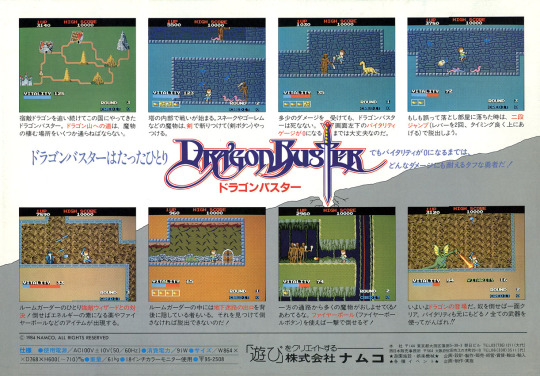
This was popular enough in Japan to be turned into a boardgame.
The graphics, while certainly acceptable for the era, are a little ‘off’, with the hero Clovis in particular looking like his arms have been put on back to front.
Finally, it also gets a little bit repetitive after a while, with the same 5 repeated level types and many of the same monsters appearing again and again.
So no forgotten classic then, but just about good enough to nudge into the bracket of ‘interesting failure’.
Playing it today
Easily emulated using MAME, but you can also pick it up (along with various other Namco arcade titles) on Namco Museum Volume 2 for the PS1, Namco Museum Battle Collection for the PSP or Namco Museum Virtual Arcade for Xbox 360.
It was also converted to the Famicom, and is playable via emulation or on Namco Museum Archives Vol 1 on Nintendo Switch. The Famicom version has quite a few changes to the arcade, with larger sprites and a more zoomed in view of the action. It’s alright as conversions go, but if you’re going to play this the arcade version is recommended.
Commentariat
Meat: This is quite an odd little footnote to Namco’s illustrious arcade heritage. They seem quite keen on it since it keeps popping up (along with Tower of Daruga) on various retro collections. It’s half a good game, and some of the ideas were really quite prescient, but if there’s one thing I can’t stand it’s games that bounce you back and forward like a beach ball in the wind when you get hit. Worse, Clovis has a shocking mullet and looks like he’s spanking one out when he walks.
Pop: I’ve always had a soft spot for Dragon Buster after first spotting it in an arcade all those years ago. I also recognise that it was quickly left behind by the rapid pace of game development at that time. You’d be better off thinking of it as a prototype for better things to come. The game mechanics of the best remembered ‘classics’ from the early 80’s are often still sound due to their appealing tightness and simplicity. The fact is that Dragon Buster is too loose and inconsistent to be worth a hearty recommendation today. Still, I got some enjoyment from dusting it off again, and there are certainly much, much worse games out there.
Score card
Presentation 6/10
A simple title screen and a fairly standard attract mode. Nothing bad here, but nothing particularly revolutionary either.
Originality 8/10
There simply weren’t any other arcade games quite like this at the time. The mixture of map screen, health bar and other ‘RPG lite’ mechanics made this a highly original offering, though it may not seem anything special today.
Graphics 6/10
A real mixed bag. Everything is bright and cleanly drawn, and the enemy designs are quite appealing. However animation is minimal, and the player character looks anatomically incorrect. It’s built on the same basic hardware as Pac-Land, but it certainly doesn’t make the same jaw-dropping ‘cartoon brought to life’ impression that game did on release.
Hookability 7/10
The game has a fairly approachable difficulty level, and there’s quite a sense of mystery to exploring it’s locations en route to battle with the dragon.
Sound 6/10
A jolly little tune burbles along while you explore the levels. It’s not unpleasant, but it’s also a total mismatch to the adventure being portrayed on screen. Something more spooky plays when you face off against one of the mini bosses in an item room. Sound effects are fairly perfunctory.
Lastability 6/10
Has quite a few levels to work your way through which become increasingly complex. These suffer from serious repetition, and you won't see anything genuinely new after the first few sets, which really kills any desire to keep playing.
Overall 6/10
Better examples of this type of game abound, but Dragon Buster got there first, and for that it deserves some recognition.
0 notes
Text
Game Review : Formula 1 Simulator
Mastertronic / 1985 / Originally £1.99 / ZX Spectrum
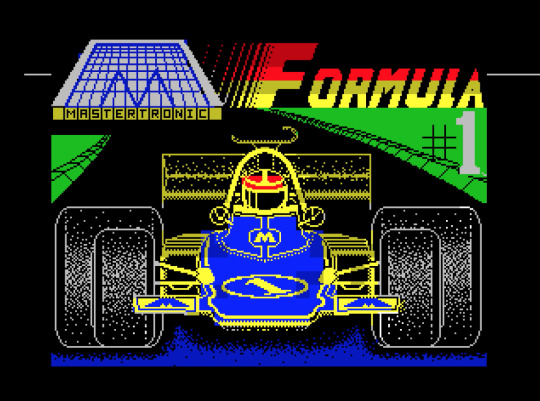
A promising start with a Lotus 72 F1 car on the loading and intro screen. Check out the size of the rear tyres on this bad-boy!
For many a small child, the dream of speeding along in a sports car is something of a pipe-dream. Past simple go-karts rented at a track, it becomes horrendously expensive to compete in a sport that has long been the plaything of the rich. Yes, the road to Formula One is paved in gold; yours. How far that road stretches depends on how much gold paving you (or more accurately, your parents) are prepared to lay down.
Even the competitors with the most humble of backgrounds will have made it thanks to a benefactor, be it a company such as Mercedes or individuals whose altruism may hide a burning desire to live out their missed opportunity through another.
Thankfully however, the computer revolution gaves those of us who can't afford the fire-retardant underwear, let alone anything else, the opportunity to give motorsport a go. Back in the early 1980s, games like Chequered Flag from Psion and Geoff Crammond’s Revs from Acornsoft put you in a single seater racing car, providing something of a sense of how it would be to race one around the world’s great circuits.
While these titles cost in excess of £6.95, the budget market was taken care of by Mastertronic whose title, Formula 1 Simulator tried to give you an opportunity to race ten circuits that were part of the Formula 1 season of the time. For modern motorsport fans, the names of the tracks might be familiar but the layouts will not. Much like a Hollywood actor feeling the pressure to look the way they did in their 20s while pushing 50, most circuits have had a lot of work done since 1985; Silverstone or Hockenheim as they are in the game are unrecognisable now. Even tracks that have only subtly changed over the years, like Monza seem radically different.
This however, is not just down to the passage of time; the circuits as they are realised in the game are not all that accurate. Back when Formula 1 Simulator was released, it is unlikely that track research involved taking the time to visit the circuits and capture the kind of information that would really be necessary to make this a detailed simulation. And, to be fair, the expense would not have been recouped in sales.

Monza’s been on the F1 calendar since 1950; it’s a solid place to start with long flowing corners.
The turns are in vaguely the right locations; but as you go round the tracks in your car, it soon becomes clear that even on a good day you and the apex of the corner are never going to get close enough to each other to be friends. Taking any kind of speed into a corner pretty much means trundling around the outside of the corner away from the racing line, no matter how hard you steer in.
Then there’s the exit of the corner. While it's hard to get the car into the corner at speed as you try to put the power down to make quick exit, the car becomes unstable. All too often this results you being flung off the track.
You might be as good as Lewis Hamilton down the kart track of a Thursday night; you might rival Damon Hill round the Tesco’s car-park getting to the last free parking space, or you might even be a credible contender to Nigel Mansell when it comes to passing a Rover 45 round the outside of a roundabout on the A34 to Stoke-on-Trent, but these skills will not help you with Formula 1 Simulator.
Each game starts with you choosing which track you’d like to drive, configuring your car with an automatic or manual gearbox to take you through the five gears and the weather (wet or dry). This is about as much setup variation as you’ll get in Formula 1 Simulator; you don’t even get to select which team you are driving for.
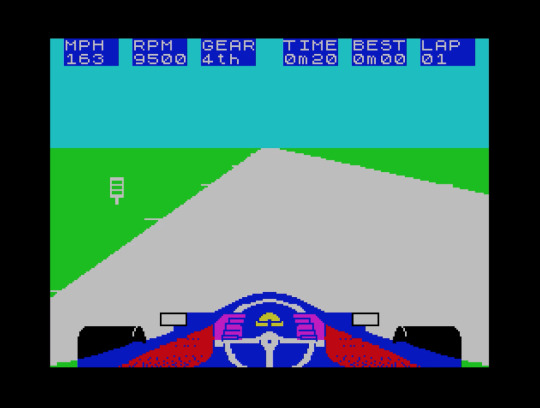
We’re off on a qualifying lap.
From there, it’s a choice between practicing a circuit or racing on it. Practicing doesn’t really add much here - it’s the qualifying for the race that is important. Although you can race, there is no championship to go with it. This really is a disappointing omission, the races feel a little aimless as a result. Mind you, there are times when just getting into the race is a victory in itself...
A race begins with qualifying - complete a lap of the circuit against the clock and you’re into a race. At no point are you told what time you are aiming at, which is a major disadvantage, nor is there any indication of how many laps you have to complete in the race should you get there. Everything here is implicit. You are expected to know that qualifying is a single lap by playing the game enough times.
Once a qualifying lap has been completed, then there is the race. While there are other cars on track to compete against, with no perspective on your rivals other than the graphic of their rear it becomes all too easy to hit them, either ramming into the back of them or unwittingly hitting them when you think you have passed them and resume the racing line. You really might think that this is an exaggeration but seriously, your opponents’ cars all seem to be simultaneously narrower and as wide as your car at the same time.
This game is very unforgiving; any mistake it seems and after a brief message to tell you that you’ve crashed you’ll have to start all over again. This starts to get old very quickly and what’s more, learning the tracks does not seem to make that much of a difference. With the handling of the car the way it is, crashing out feels more like a lottery, rather than down to anything else.

And they’re GO! GO! GO!
Some of Formula 1 Simulator’s shortcomings come from the game having been written with a 16k Spectrum in mind. Unlike a game like Beach-Head on the Commodore 16 where the lameness could have been avoided with some careful consideration and design, many of the problems with the game stem from trying to cram as much realism as you can into such a tiny memory footprint.
Mastertronic certainly took a different approach with the title on the Commodore machines; perhaps it was for the best. While Formula 1 Simulator isn’t going to win any prizes for realism, it should at least be rewarded for being a valiant attempt to try and lever a realistic driving simulator into such a low-spec machine.
Spirit Software and the Kensington CID
Mastertronic’s Formula 1 Simulator was a re-release of a title from another company called Spirit Software who, in 1984 had released the game for the princely sum of £8.95 promising their own steering wheel add-on.
This was quite something for the time; such devices were not really seen outside of the arcades, with games like Sprint or Pole Position having basic wheels and a simple Hi/Low gear shifter.
First versions of the game are alleged to have been sent out with what has been referred to in unflattering terms as a yellow plastic ash-tray that sat on the relevant keys. We’re yet to find a picture of this device in the wild, so it might just be a reference to the instructions in the Mastertronic version that suggested using a Sellotape tin along the keys at the top at the top of the computer.
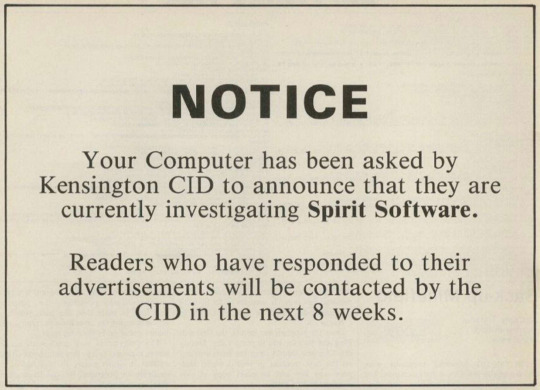
The announcement from June 1984′s Your Computer magazine. [source - archive.org]
Sadly, while the cash for the enterprise readily appeared from Spectrum owners keen to try out the latest fad in games, the hardware did not and by the summer of 1984, Kensington CID (part of London’s Metropolitan Police) were investigating Spirit Software, eventually returning cheques that had not been cashed to those who had been keen to have a more realistic shot at F1 from the comfort of their own homes. Those that had been cashed, well, it seems that money was lost.
What became of the owners of Spirit Software? And more importantly the cash? It’s not entirely clear as the trail of the story dries up with the Police getting involved; presumably the enigmatic author of the game, S.C. Stephens must have sold the game on to Mastertronic, where it became a real money spinner. Across all formats, Formula 1 Simulator sold in excess of half a million copies for its new publisher...
Buying it today
Given it’s a budget title that was available just about everywhere, it’s not in short supply today. If you’re spending £5 including postage you’re spending a lot.
Commentariat
Tim : How I wish this game was different, just a few tweaks here and there could turn this from being a dog of a game into something far more playable.
The steering controls are shocking, and without the ability to change much about the setup of the car (given the release date of the game, this genuinely would be too much to ask), hobbling the game to such an extent that it’s a chore to play. The solution provided by both original developer Spirit and kept by Mastertronic, to have a control mode that needs you to roll - yes roll - a wheel across the top row of a rubber-key Spectrum’s keyboard is as much bizarre, as to how little it is future proof. Fortunately, Mastertronic also added joystick support as well as a more traditional keyboard control option.
After spending more time restarting the game after a crash than actually driving, I just pootled around Monza with automatic gears turned on at a slow speed to get into the race. Manual gears I found impossible due to their poor placing on the keyboard. I had no idea what time I was aiming for to secure pole position, so for all I knew I might be fastest. I wasn’t. Even so, I was in the race, but with no idea how long it would be. I went for it - and crashed right after passing a car.
That was pretty much it for me.
If you can afford to spend memory on a pretty title screen of a Lotus 72, you can afford to improve the in-game data. Or failing that, include a championship mode, or offer team selection, or just about anything from a long list of things that would have been cheap in memory terms, but have added a lot to the game.
With a simulation so poor it’s incredible, but entirely predictable, that Mastertronic stuck with it for the Amstrad and MSX machines instead of converting the far more playable Commodore 64 version.
If you are a driving sim fan, there is only one word for this. Avoid.
Score Lord : Hmmm. I remember this the first time round for all the wrong reasons. While many companies have taken your money and had a liberal interpretation of 28 days delivery when it came to some of their products, their kit usually turned up. Unless it’s a Spectrum Vega+.
I agree that this is hardly a realistic sim but think about what it did for society. First, it no doubt gave people the opportunity to say “I can do better than that” and produce racing titles of their own. Second, it put to bed the idea that an ashtray could be used as a steering wheel once and for all. Saved British Leyland a fortune in R&D, that.
Meat : The day I got my Spectrum, I bought this title. I was already starting to get a feel for motorsport, mostly thanks to an ever-present Nigel Mansell on the TV each Sunday lunchtime in the summer.
My disappointment as a child wasn’t the graphics or the sound, it was that the game was so hard. Even today, I like the way that the car accelerates away with a little chirp from the speaker to mimic wheelspin and that you have to brake properly into the corners. The sad thing was that it wasn’t arcade-y enough in the way it played for me and not simulator-y enough for my Dad. Formula 1 Simulator is kind of an in between sort of game with elements of both but not enough of either to make it work.
After a while I managed to get around the circuit without bouncing off to make it to the race, but when I did, I crashed more or less straight away. This cycle repeated so often I don’t really ever remember finishing a single first lap. I eventually lost interest. Even today, while I can get into the race most of the time, I don’t really want to go any further knowing that I’ll just end up hitting another car.
Due to a minor misunderstanding I was not allowed to try the Sellotape tin steering wheel back in the day, as my father misinterpreted what I intended to do and refused to let me try it out. Without my Dad to tell me otherwise, I’ve tried this as an adult and, yes, it does work but doesn’t make much of a difference. Just makes you look like a weirdo at a gaming expo.
This really seemed to be a game where the developer’s ambition was way beyond the capabilities of the technology at the time, rather than the other way round. Well, that’s how I like to think of it.
Score card
Presentation 4/10
The exciting cover art and well-drawn loading screen soon give way to a lack-lustre menu and garish colours in-game. Good choice of tracks if you had a 48k Spectrum, mind. The steering wheel control method is just, well, odd.
Originality 7/10
At a time when most driving games were top-down sprint-style games or variations on Pole Position, this certainly tried to be different and succeeds.
Graphics 4/10
Middling; the game’s colour palette is horrific, the other cars basic. The track moves nicely, but the sense of speed is diminished with a dearth of roadside objects. Corner markers while present, are so small you easily miss them, making them more or less pointless.
Hookability 2/10
Unfortunately, the game is unrewarding to play mostly because a tiny mistake means it’s all over.
Sound 2/10
While the C64 version had a cool soundtrack courtesy of Rob Hubbard, which also made it onto the Amstrad and MSX conversions, the Spectrum has some basic engine noises and that’s about all. This does add something to the game, but won't win any awards.
Lastability 3/10
Good selection of tracks, even if they are unrealistically modelled, but the unforgiving nature of the game you’d need to be a masochist to keep playing it.
Value for Money 3/10
It was £1.99 at the time of release by Mastertronic, which meant you got a half decent amount of car sim for your money.
Overall 3/10
It’s really difficult to work out if this was a valiant effort that just tried to do too much with too little, or just something that Mastertronic picked up to fill a slot in a software library. Either way though, it’s not good enough to keep you coming back.
0 notes